More than 60 projects will be on display in 2022 as the college celebrates the hard work and innovation of its seniors.
Biological Systems Engineering
Baja Rear Steer System
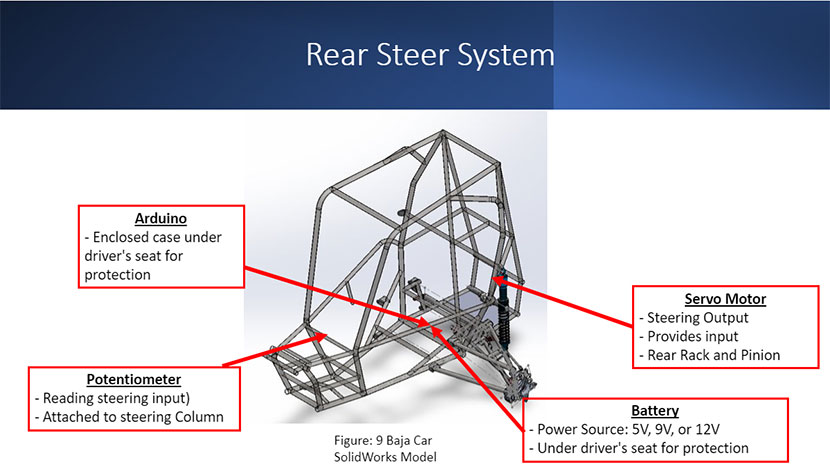
Team Members
Cole Culver
Jacob Janak
Lukas Stelzle
Zhihao Gong
Faculty Supervisor
Tami Brown-Brandl
Project Description
We are implementing a rear steering system in the UNL Baja team's car. This will be achieved by the use of a potentiometer, Arduino control board, rack and pinion, and a servo motor.
Cole Culver
Jacob Janak
Lukas Stelzle
Zhihao Gong
Faculty Supervisor
Tami Brown-Brandl
Project Description
We are implementing a rear steering system in the UNL Baja team's car. This will be achieved by the use of a potentiometer, Arduino control board, rack and pinion, and a servo motor.
CLAAS Corn Head Hood and Point Automatic Folding Design
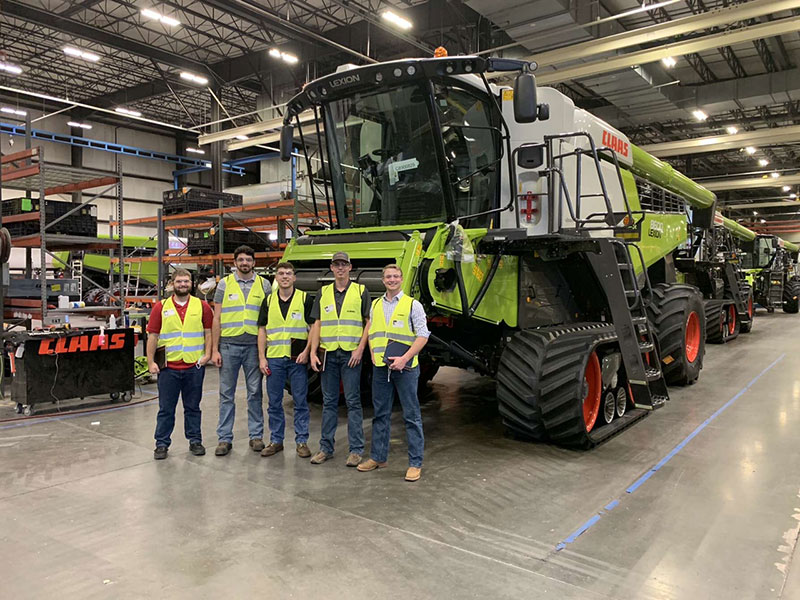
Team Members
Thomas Janecek
Max Hansen
Nathan Lancaster
Casey Johnson
Jacob Potratz
Faculty Supervisor
Terry Howell
Project Description
Our group was tasked with designing a solution to automatically raise and lower the hood and point assembly of a CLAAS corn head. This design would save farmers time and energy when preparing to travel between fields and protect from injury as well.
Thomas Janecek
Max Hansen
Nathan Lancaster
Casey Johnson
Jacob Potratz
Faculty Supervisor
Terry Howell
Project Description
Our group was tasked with designing a solution to automatically raise and lower the hood and point assembly of a CLAAS corn head. This design would save farmers time and energy when preparing to travel between fields and protect from injury as well.
Remediation of AltEn Poisoning with Neonicotinoid (Neurotoxic Insecticide) in ENREC Water
Team Members
Scott Smith
Jordan Talmon
Dawson Bartunek
Helen Little
Taya Derun
Faculty Supervisor
Tami Brown-Brandl
Project Description
We have designed a treatment train to treat insecticide neurotoxins (neonicotinoids) on a large-scale ans counter the illegal dumping of contaminated seed corn from a company called AltEn in Mead, Nebraska. The seed corn was covered with the neonicotinoids and has poisoned surface and groundwater causing long-lasting effects to animals and humans.
Scott Smith
Jordan Talmon
Dawson Bartunek
Helen Little
Taya Derun
Faculty Supervisor
Tami Brown-Brandl
Project Description
We have designed a treatment train to treat insecticide neurotoxins (neonicotinoids) on a large-scale ans counter the illegal dumping of contaminated seed corn from a company called AltEn in Mead, Nebraska. The seed corn was covered with the neonicotinoids and has poisoned surface and groundwater causing long-lasting effects to animals and humans.
Synthetic Canine Abdominal Palpation Model
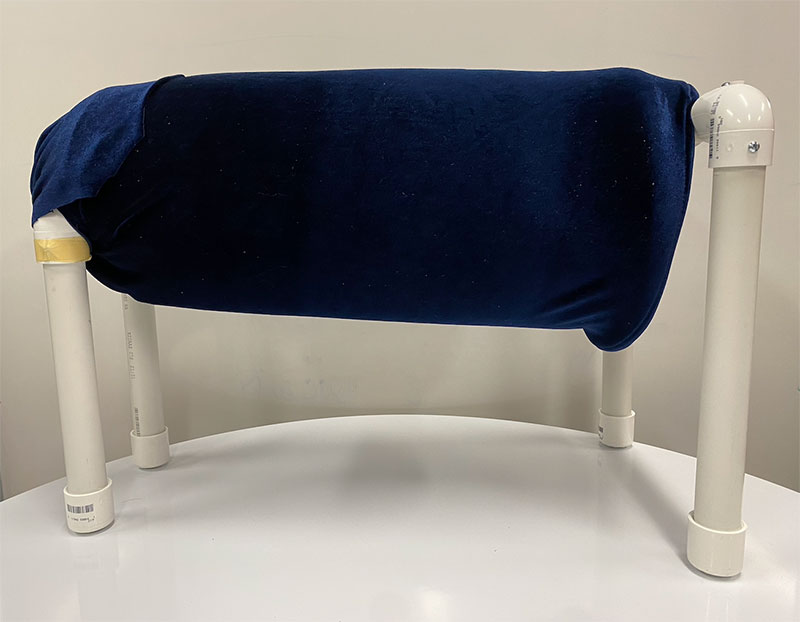
Team Members
Michaela Ott
Regan Monhollon
Jason Subick II
Susan Qudus
Faculty Supervisor
Tami Brown-Brandl and Terry Howell
Project Description
Our model will be used by veterinary students at UNL to learn the essential technique of abdominal palpation. There is a shortage of synthetic models and canine cadavers for veterinary students to learn this skill, so this model will allow them to further their studies and become better veterinarians for their future patients.
Michaela Ott
Regan Monhollon
Jason Subick II
Susan Qudus
Faculty Supervisor
Tami Brown-Brandl and Terry Howell
Project Description
Our model will be used by veterinary students at UNL to learn the essential technique of abdominal palpation. There is a shortage of synthetic models and canine cadavers for veterinary students to learn this skill, so this model will allow them to further their studies and become better veterinarians for their future patients.
Stormwater BMP Implementation for Douglas County Environmental Services
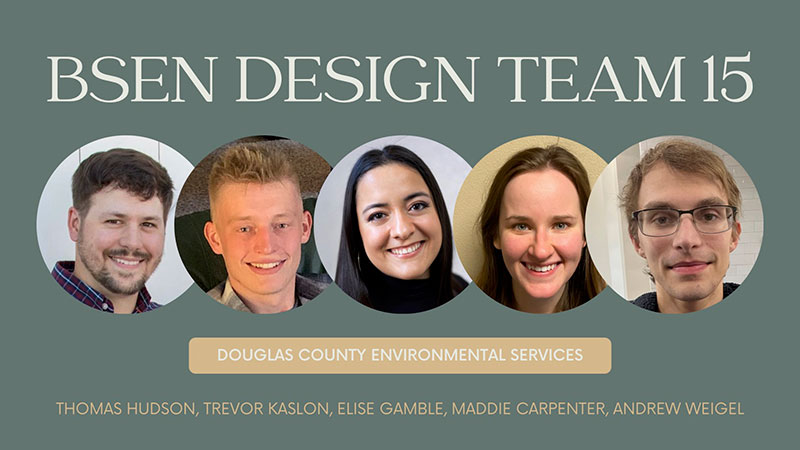
Team Members
Maddie Carpenter
Thomas Hudson
Andrew Weigel
Elise Gamble
Trevor Kaslon
Faculty Supervisor
Terry Howell
Project Description
Douglas County Environmental Services (DCES) is responsible for the environmental health of Douglas County, Nebraska. DCES coordinates environmental services for land use, stormwater management, weed control, and solid waste. DCES expressed that it is the department’s desire to add more best management practices (BMPs) on their property at 15335 W. Maple Road in Omaha.
Implementing sustainable practices on the property shows the department’s commitment to building an environmentally friendly county. Stormwater runoff from the southern side of the DCES building is currently diverted directly to city storm drains. The stormwater is underutilized and carries excess pollutants into Douglas County waterways. Capturing and filtering this storm water is essential in making the site more sustainable.
A treatment train has been proposed to both aid in the increased filtration and infiltration of stormwater on site. Treatment trains are composed of several BMPs which can be implemented in steps. The final results will reduce runoff and pollution. Components of the proposed treatment train include permeable pavers, sedge/rush gardens, and a bioretention garden in which overflow is conveyed to the neighboring storm drain.
Maddie Carpenter
Thomas Hudson
Andrew Weigel
Elise Gamble
Trevor Kaslon
Faculty Supervisor
Terry Howell
Project Description
Douglas County Environmental Services (DCES) is responsible for the environmental health of Douglas County, Nebraska. DCES coordinates environmental services for land use, stormwater management, weed control, and solid waste. DCES expressed that it is the department’s desire to add more best management practices (BMPs) on their property at 15335 W. Maple Road in Omaha.
Implementing sustainable practices on the property shows the department’s commitment to building an environmentally friendly county. Stormwater runoff from the southern side of the DCES building is currently diverted directly to city storm drains. The stormwater is underutilized and carries excess pollutants into Douglas County waterways. Capturing and filtering this storm water is essential in making the site more sustainable.
A treatment train has been proposed to both aid in the increased filtration and infiltration of stormwater on site. Treatment trains are composed of several BMPs which can be implemented in steps. The final results will reduce runoff and pollution. Components of the proposed treatment train include permeable pavers, sedge/rush gardens, and a bioretention garden in which overflow is conveyed to the neighboring storm drain.
Beef Nutrition Feeding System
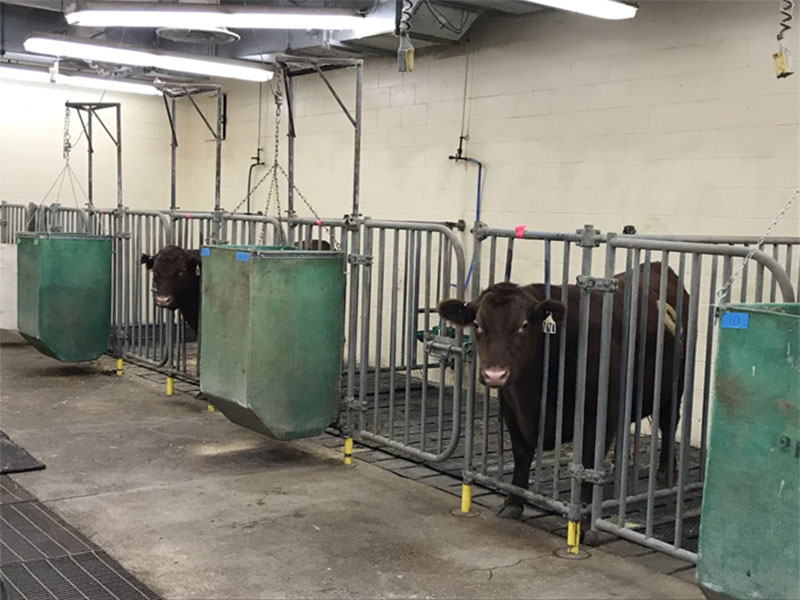
Team Members
Ryan Walker
Von Fritsche
Reece McFarland
Brendan Pojar
Riley Pollock
Faculty Supervisor
Tami Brown-Brandl
Project Description
The Animal Science Department is using a hanging system to continuously weigh feed consumed by a single animal during nutrition trials. Our goal is to design individual feed bunks that will replace the current system to improve ease of cleaning, transporting, durability, and cost-effectiveness.
Ryan Walker
Von Fritsche
Reece McFarland
Brendan Pojar
Riley Pollock
Faculty Supervisor
Tami Brown-Brandl
Project Description
The Animal Science Department is using a hanging system to continuously weigh feed consumed by a single animal during nutrition trials. Our goal is to design individual feed bunks that will replace the current system to improve ease of cleaning, transporting, durability, and cost-effectiveness.
Musical Soccer Goal

Team Members
Shea Thompson
Madison Seefeld
Brandon Bakenhus
Thomas Peck
Faculty Supervisor
Terry Howell
Project Description
We designed a soccer goal for visually impaired and special needs children that plays music when a goal is scored.
Shea Thompson
Madison Seefeld
Brandon Bakenhus
Thomas Peck
Faculty Supervisor
Terry Howell
Project Description
We designed a soccer goal for visually impaired and special needs children that plays music when a goal is scored.
Cast Dryer
Team Members
Ava Todora
Josh Wagner
Nilson Aguilar
Yvette Pearson
Faculty Supervisor
Tami Brown-Brandl and Terry Howell
Project Description
There is a need to design a device/method that can safely dry children’s casts to eliminate the possibility of tissue swelling/irritation from prolonged water exposure while maintaining the cast’s structural integrity, which in turn will prevent the need for recasting.
Ava Todora
Josh Wagner
Nilson Aguilar
Yvette Pearson
Faculty Supervisor
Tami Brown-Brandl and Terry Howell
Project Description
There is a need to design a device/method that can safely dry children’s casts to eliminate the possibility of tissue swelling/irritation from prolonged water exposure while maintaining the cast’s structural integrity, which in turn will prevent the need for recasting.
Quarter-scale Tractor Design
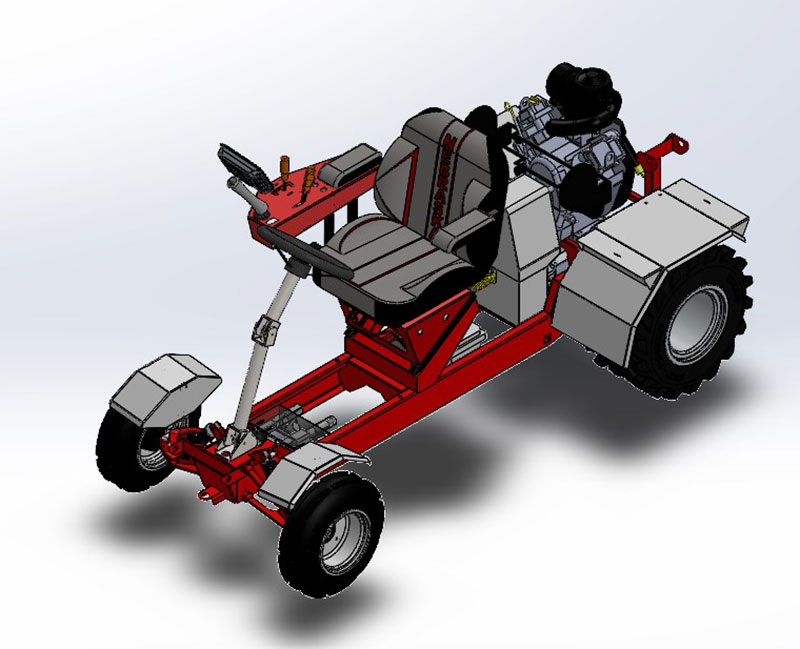
Team Members
Brittani Wacker
Jaci Kurkowski
Dalton Erickson
Andrew Lutt
Faculty Supervisor
Terry Howell
Project Description
This year, the Quarter-scale Tractor Design Team has created an adjustable brake system to increase ergonomics. The design includes a new brake box that is electrically actuated to adjust the brake pedals to the operator's preferred setting.
Brittani Wacker
Jaci Kurkowski
Dalton Erickson
Andrew Lutt
Faculty Supervisor
Terry Howell
Project Description
This year, the Quarter-scale Tractor Design Team has created an adjustable brake system to increase ergonomics. The design includes a new brake box that is electrically actuated to adjust the brake pedals to the operator's preferred setting.
Bone Port

Team Members
Morgan Lease
Garret Williams
Justin Dyke
Ana Figueroa
Faculty Supervisor
Tami Brown-Brandl
Project Description
The BonePort device is designed for children who are experiencing necrosis of the femoral head. This is currently treated by two cannulated screws being placed into the femoral head, one for suction and the other for irrigation. The BonePort device will reduce the invasive process by only using one screw.
Morgan Lease
Garret Williams
Justin Dyke
Ana Figueroa
Faculty Supervisor
Tami Brown-Brandl
Project Description
The BonePort device is designed for children who are experiencing necrosis of the femoral head. This is currently treated by two cannulated screws being placed into the femoral head, one for suction and the other for irrigation. The BonePort device will reduce the invasive process by only using one screw.
Adaptation to Total Gym in Gait Lab

Team Members
Brandon Vogel
Alvaro Moreno Lozano
Hannah Keinath
Isabel Chavez
Faculty Supervisor
Terry Howell
Project Description
Adapt the sled of a total gym at UNMC to help aid patients in physical rehabilitation programs.
Brandon Vogel
Alvaro Moreno Lozano
Hannah Keinath
Isabel Chavez
Faculty Supervisor
Terry Howell
Project Description
Adapt the sled of a total gym at UNMC to help aid patients in physical rehabilitation programs.
Tibial Stent 2.0
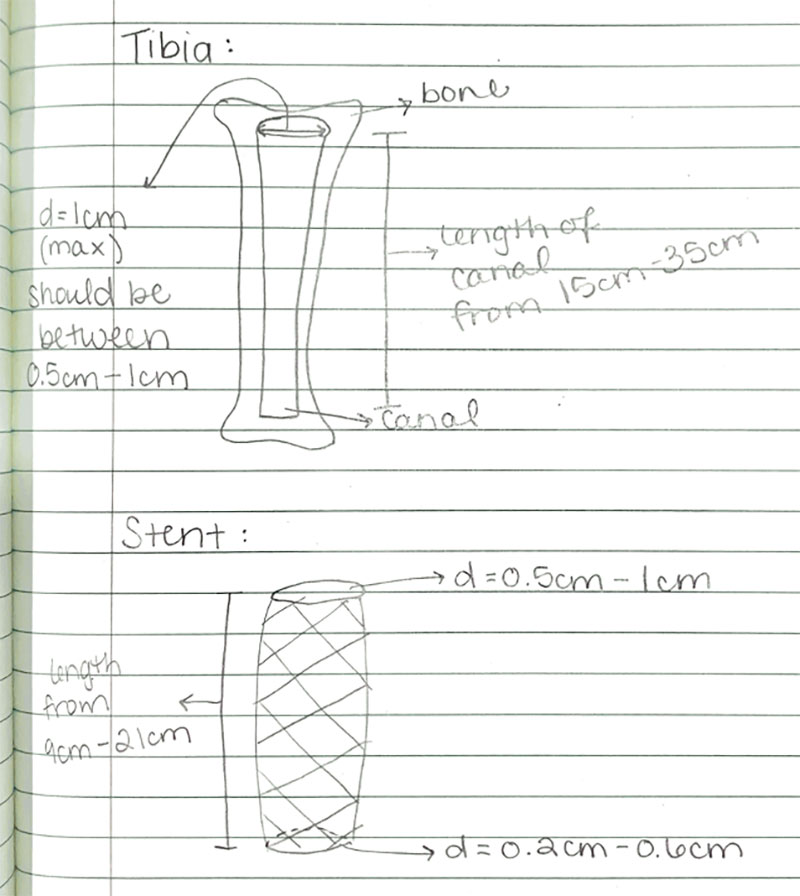
Team Members
Anika Dujakovich
Morgan McArthur
Kelly Broad
Victor Moreno-Lozano
Faculty Supervisor
Tami Brown-Brandl
Project Description
Tibial fractures are a common pediatric fracture site with an estimated one in three of these fractures being treated via surgical operation. This surgical intervention could exacerbate inflammatory responses and lead to complications in healing and recovery. Traditional methods of stent implementation in adults do not carry over to pediatric patients. Because of this, an expandable tibial stent model is needed that properly provides structure to medullary cavities in pediatric patients between the ages of 4 and 14.
Anika Dujakovich
Morgan McArthur
Kelly Broad
Victor Moreno-Lozano
Faculty Supervisor
Tami Brown-Brandl
Project Description
Tibial fractures are a common pediatric fracture site with an estimated one in three of these fractures being treated via surgical operation. This surgical intervention could exacerbate inflammatory responses and lead to complications in healing and recovery. Traditional methods of stent implementation in adults do not carry over to pediatric patients. Because of this, an expandable tibial stent model is needed that properly provides structure to medullary cavities in pediatric patients between the ages of 4 and 14.
Toilet Fall Prevention
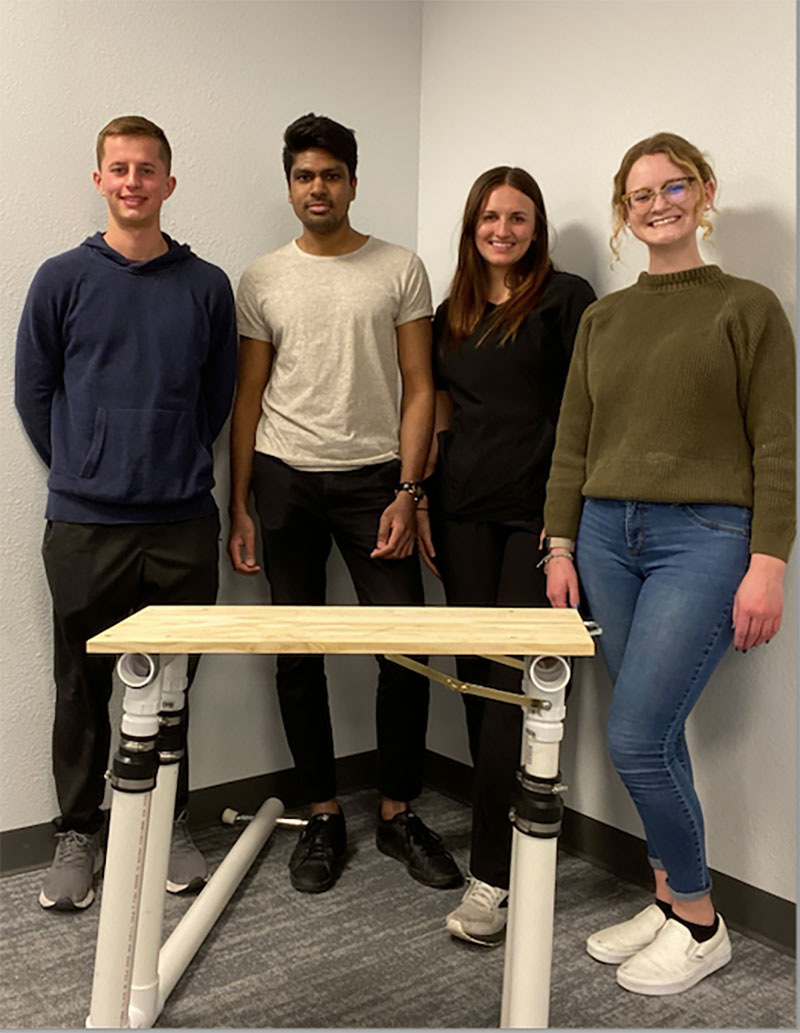
Team Members
Honoria Clarke
Emily Schomburg
Nathan Turner
Ikhlaas Mungloo
Faculty Supervisor
Tami Brown-Brandl and Terry Howell
Project Description
Falls for hospitalized patients often occur in the bathroom. When patients are at increased risk of falling, nurses may be required to stay in the bathroom with the patient. However, this is not comfortable for the patient and compliance can be poor with this practice. We created a design to retrofit the bathroom and reduce falls from the toilet when nurses are unable to assist the patients.
Honoria Clarke
Emily Schomburg
Nathan Turner
Ikhlaas Mungloo
Faculty Supervisor
Tami Brown-Brandl and Terry Howell
Project Description
Falls for hospitalized patients often occur in the bathroom. When patients are at increased risk of falling, nurses may be required to stay in the bathroom with the patient. However, this is not comfortable for the patient and compliance can be poor with this practice. We created a design to retrofit the bathroom and reduce falls from the toilet when nurses are unable to assist the patients.
Variable Stiffness Shoe
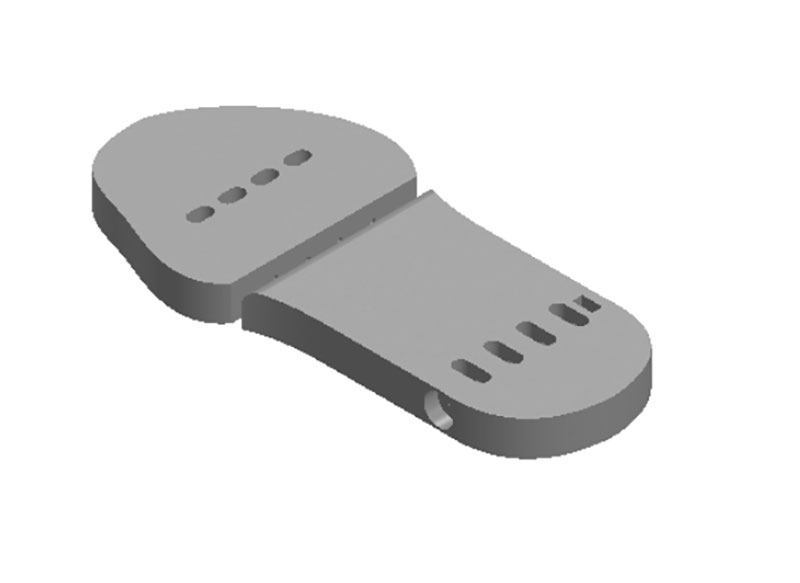
Team Members
Chandler Brock
TJ Ripperda
Nate Brandyberry
Michael Kathol
Faculty Supervisor
Tami Brown-Brandl
Project Description
This project consists of a variable stiffness shoe that increases and decreases stiffness upon tuning. Guitar strings are implanted into the device and used to tighten the stiffness when the shoe is used for running and lessen the stiffness when it is used for walking. Research shows that a stiffer shoe will increase efficiency during running and a less-stiff shoe will increase efficiency during walking.
Chandler Brock
TJ Ripperda
Nate Brandyberry
Michael Kathol
Faculty Supervisor
Tami Brown-Brandl
Project Description
This project consists of a variable stiffness shoe that increases and decreases stiffness upon tuning. Guitar strings are implanted into the device and used to tighten the stiffness when the shoe is used for running and lessen the stiffness when it is used for walking. Research shows that a stiffer shoe will increase efficiency during running and a less-stiff shoe will increase efficiency during walking.
Chemical & Biomolecular Engineering
Greener Production of VCM from Bioethanol, Ethylene, Chlorine, and Oxygen
Team Members
Nathan D Kreutzer
Chris Merkel
Yue Wang
Cameron Gilley
Faculty Supervisor
Yasar Demirel
Project Description
The Greener production of VCM from Bioethanol, Ethylene, Chlorine, and Oxygen.
Nathan D Kreutzer
Chris Merkel
Yue Wang
Cameron Gilley
Faculty Supervisor
Yasar Demirel
Project Description
The Greener production of VCM from Bioethanol, Ethylene, Chlorine, and Oxygen.
Urea Production via an Electrochemical Synthesis of Ammonia and CO2 from Ethanol Plant
Team Members
David Magloire Kongolo
Dustin Sprunk
Aingaran Bala Raman
Chao Lu
Faculty Supervisor
Yasar Demirel
Project Description
Our project is about producing urea by using sustainable technologies. Ammonia is needed to produce urea; however, it is supplied by the Haber-Bosh Process, which is not a sustainable process. For our production of urea, we are using ammonia produced via an electro-catalysis of water and reacting that with N2. We are also using CO2 from a sustainable ethanol plant.
David Magloire Kongolo
Dustin Sprunk
Aingaran Bala Raman
Chao Lu
Faculty Supervisor
Yasar Demirel
Project Description
Our project is about producing urea by using sustainable technologies. Ammonia is needed to produce urea; however, it is supplied by the Haber-Bosh Process, which is not a sustainable process. For our production of urea, we are using ammonia produced via an electro-catalysis of water and reacting that with N2. We are also using CO2 from a sustainable ethanol plant.
Green Production of Fuel and Chemicals from Renewable Carbon and Energy
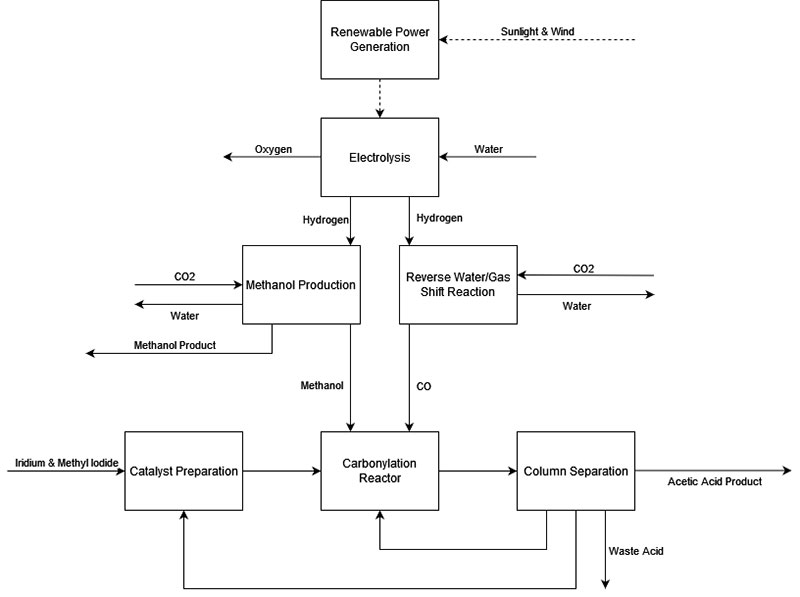
Team Members
Mason Bowser
Samantha Harvat
Daniel Le
Winston Obal
Faculty Supervisor
Yasar Demirel
Project Description
This project will utilize CO2 from ethanol plants in Nebraska and convert it into methanol and acetic acid, two important commodity chemicals. Hydrogen, also needed to produce these chemicals, will be generated through the electrolysis of water. To offset the power used by the process, the installation of renewable wind and solar energy sources are incorporated into the design. The process was designed, simulated, and optimized using Aspen Plus. Emphasis was placed on increasing ecological sustainability while maintain economic feasibility.
Mason Bowser
Samantha Harvat
Daniel Le
Winston Obal
Faculty Supervisor
Yasar Demirel
Project Description
This project will utilize CO2 from ethanol plants in Nebraska and convert it into methanol and acetic acid, two important commodity chemicals. Hydrogen, also needed to produce these chemicals, will be generated through the electrolysis of water. To offset the power used by the process, the installation of renewable wind and solar energy sources are incorporated into the design. The process was designed, simulated, and optimized using Aspen Plus. Emphasis was placed on increasing ecological sustainability while maintain economic feasibility.
The Improved Production of Titanium Dioxide
Team Members
Jackson Goddard
Claire Maaliao
Joe Heglin
Brandon Yost
Faculty Supervisor
Yasar Demirel
Project Description
The goal of the design project is to produce titanium dioxide from ilmenite utilizing a chloride leaching process while also separating out and purifying carbon dioxide to be sold off as a byproduct to another industry.
Jackson Goddard
Claire Maaliao
Joe Heglin
Brandon Yost
Faculty Supervisor
Yasar Demirel
Project Description
The goal of the design project is to produce titanium dioxide from ilmenite utilizing a chloride leaching process while also separating out and purifying carbon dioxide to be sold off as a byproduct to another industry.
Bioeconomy of Converting Carbon Dioxide to Chemicals and Polymers

Team Members
Seth Stroh
Clint Koetter
Leila Ba
Emme Campbell
Faculty Supervisor
Yasar Demirel
Project Description
Polyvinyl chloride (PVC) is the world’s third most produced plastic polymer. Currently, PVC is commonly plasticized using phthalates. Recent studies on phthalate esters (PAEs) show that PAE exposure has damaging effects on the environment. They represent a risk for aquatic and terrestrial ecosystems and have serious health impacts on humans.
To solve this problem, an environmentally friendly and non-toxic PVC plasticizer will be synthesized from a CO2-based polycarbonate as a substitute for phthalates. Additionally, depending on market demand, polypropylene carbonate can be produced and sold. Aspen was used to determine the economic and environmental sustainability of the process by utilizing energy analysis and optimization tools within the program.
Seth Stroh
Clint Koetter
Leila Ba
Emme Campbell
Faculty Supervisor
Yasar Demirel
Project Description
Polyvinyl chloride (PVC) is the world’s third most produced plastic polymer. Currently, PVC is commonly plasticized using phthalates. Recent studies on phthalate esters (PAEs) show that PAE exposure has damaging effects on the environment. They represent a risk for aquatic and terrestrial ecosystems and have serious health impacts on humans.
To solve this problem, an environmentally friendly and non-toxic PVC plasticizer will be synthesized from a CO2-based polycarbonate as a substitute for phthalates. Additionally, depending on market demand, polypropylene carbonate can be produced and sold. Aspen was used to determine the economic and environmental sustainability of the process by utilizing energy analysis and optimization tools within the program.
Production of Biofuel from Spent Coffee Grounds
Team Members
Noha Algahimi
Xuan Le
Serena Tenhumberg
Nevaeh Hall
Faculty Supervisor
Yasar Demirel
Project Description
Dimethyl ether (DME) is a synthetically derived colorless gas that can be used as an alternative source of fuel for diesel engines. DME combined with biodiesel can promote sustainability by reducing carbon emissions due to a relatively high oxygen content compared to other market diesel fuels.
This design project aims to curate a process through which DME can be efficiently and sustainably produced using spent coffee ground biomass as a hydrogen source. Spent coffee grounds will be obtained through decentralized procurement across the United States. The gasification of biomass to produce hydrogen yields 2423.68 kg/hr of hydrogen. Methanol synthesis yields 26,934 kg/hr of methanol and final DME synthesis yields 13684.41 kg/hr of DME.
Current global warming potential for this process, determined through a CO2 equivalency calculation, is 25.84 kg/s.
Noha Algahimi
Xuan Le
Serena Tenhumberg
Nevaeh Hall
Faculty Supervisor
Yasar Demirel
Project Description
Dimethyl ether (DME) is a synthetically derived colorless gas that can be used as an alternative source of fuel for diesel engines. DME combined with biodiesel can promote sustainability by reducing carbon emissions due to a relatively high oxygen content compared to other market diesel fuels.
This design project aims to curate a process through which DME can be efficiently and sustainably produced using spent coffee ground biomass as a hydrogen source. Spent coffee grounds will be obtained through decentralized procurement across the United States. The gasification of biomass to produce hydrogen yields 2423.68 kg/hr of hydrogen. Methanol synthesis yields 26,934 kg/hr of methanol and final DME synthesis yields 13684.41 kg/hr of DME.
Current global warming potential for this process, determined through a CO2 equivalency calculation, is 25.84 kg/s.
Bioeconomy of producing specialty chemicals in a biorefinery
Team Members
Adam Eddy
Allyson Henry
Ethan Glenn
Faculty Supervisor
Yasar Demirel
Project Description
There is an increasing focus on reducing waste, carbon emissions, and using more renewable feedstocks. In the industrial sector, the chemical subsector consumes the largest amount of oil and gas and is the third-largest direct carbon emitter. One solution to this problem is designing processes based on a bioeconomy that utilize renewable feedstocks. Through the use of the latest technologies and computer-aided design, we propose a specialty chemical biorefinery based on a bioeconomy.
Our process utilizes a feedstock of lignocellulose, such as corn stovers, to produce a main product of 1,4-butanediol and specialty chemical byproducts including succinic acid, gamma-butyrolactone, and tetrahydrofuran. The process utilizes lignocellulose by extracting fermentable sugars and producing succinic acid through fermentation. The succinic acid is converted to our products through a hydrogenation reaction using green hydrogen followed by a series of separation processes. This project aims to minimize waste and the usage of water, solvents, and energy through rigorous energy and separation process optimization.
The economic and sustainability analysis of our process was also assessed through feasibility analysis.
Adam Eddy
Allyson Henry
Ethan Glenn
Faculty Supervisor
Yasar Demirel
Project Description
There is an increasing focus on reducing waste, carbon emissions, and using more renewable feedstocks. In the industrial sector, the chemical subsector consumes the largest amount of oil and gas and is the third-largest direct carbon emitter. One solution to this problem is designing processes based on a bioeconomy that utilize renewable feedstocks. Through the use of the latest technologies and computer-aided design, we propose a specialty chemical biorefinery based on a bioeconomy.
Our process utilizes a feedstock of lignocellulose, such as corn stovers, to produce a main product of 1,4-butanediol and specialty chemical byproducts including succinic acid, gamma-butyrolactone, and tetrahydrofuran. The process utilizes lignocellulose by extracting fermentable sugars and producing succinic acid through fermentation. The succinic acid is converted to our products through a hydrogenation reaction using green hydrogen followed by a series of separation processes. This project aims to minimize waste and the usage of water, solvents, and energy through rigorous energy and separation process optimization.
The economic and sustainability analysis of our process was also assessed through feasibility analysis.
Electrical & Computer Engineering
Multi-Filament 3D Printer
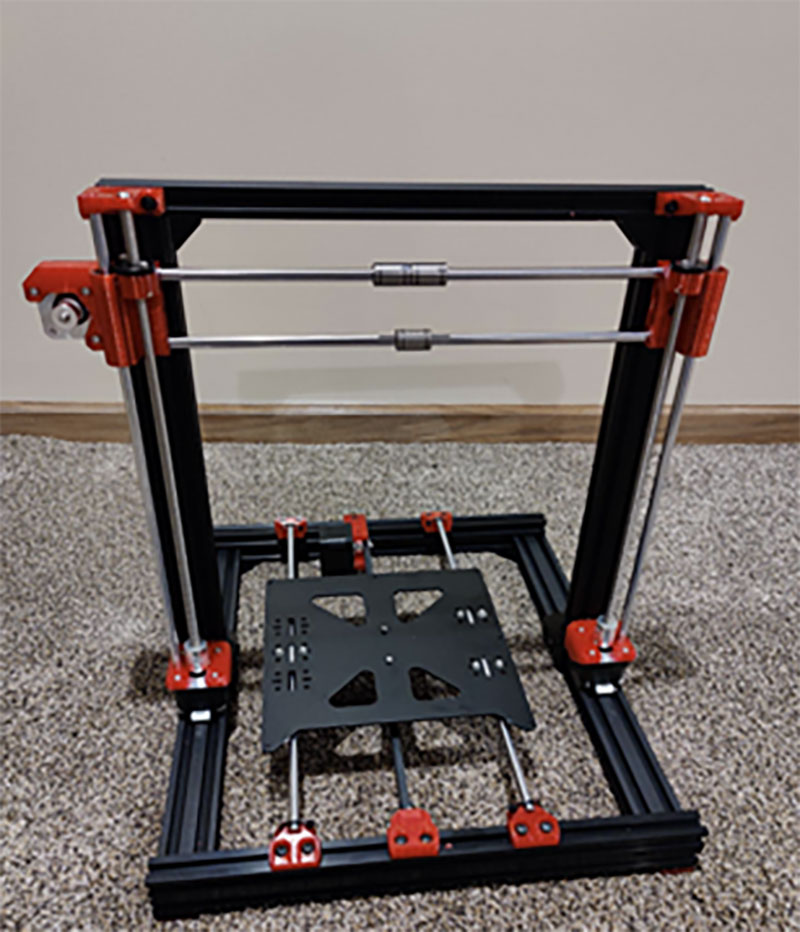
Team Members
Gwyn Semanisin
Jake Tierney
Elliott Wolbach
Travis Bond
Faculty Supervisor
Herbert Detloff
Project Description
A FDM 3D printer that can autonomously switch between various types of filaments in a single print without material waste. The project involved designing a custom filament-selection unit, heating elements, and a main control board.
Gwyn Semanisin
Jake Tierney
Elliott Wolbach
Travis Bond
Faculty Supervisor
Herbert Detloff
Project Description
A FDM 3D printer that can autonomously switch between various types of filaments in a single print without material waste. The project involved designing a custom filament-selection unit, heating elements, and a main control board.
License to Gill
Team Members
Mark Stearman
Jonah Letak
Grayson Stanton
Gavyn Klein
Faculty Supervisor
Herbert Detloff
Project Description
This project involves the design and prototyping of a stand-alone, remotely accessible monitor and control system for a saltwater fish aquarium.
Mark Stearman
Jonah Letak
Grayson Stanton
Gavyn Klein
Faculty Supervisor
Herbert Detloff
Project Description
This project involves the design and prototyping of a stand-alone, remotely accessible monitor and control system for a saltwater fish aquarium.
Moisture Data Logger

Team Members
Nikita Estrada
Jacob Cleveland
Justine Linscott
Yutaro Matsuda
Faculty Supervisor
Herbert Detloff
Project Description
A sensor network for collecting moisture data with 4G LTE connectivity and a web interface.
Nikita Estrada
Jacob Cleveland
Justine Linscott
Yutaro Matsuda
Faculty Supervisor
Herbert Detloff
Project Description
A sensor network for collecting moisture data with 4G LTE connectivity and a web interface.
Resistance Temperature Detector (RTD) Test Set
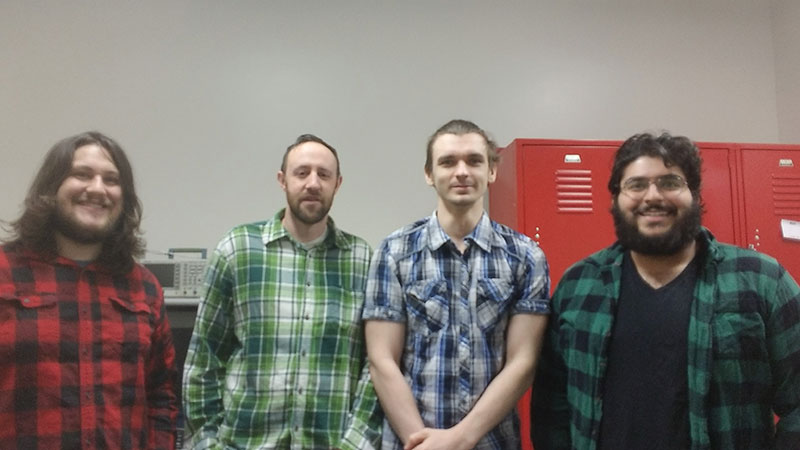
Team Members
Martin Reistad
Jacob Linzer
Nathan Meyer
Neil Koul
Faculty Supervisor
Herbert Detloff
Project Description
Our project is a test set that checks for RTD sensor degradation using a series of tests involving sending different currents through an RTD and measuring its response characteristics.
Martin Reistad
Jacob Linzer
Nathan Meyer
Neil Koul
Faculty Supervisor
Herbert Detloff
Project Description
Our project is a test set that checks for RTD sensor degradation using a series of tests involving sending different currents through an RTD and measuring its response characteristics.
King Kobb Plays Chess
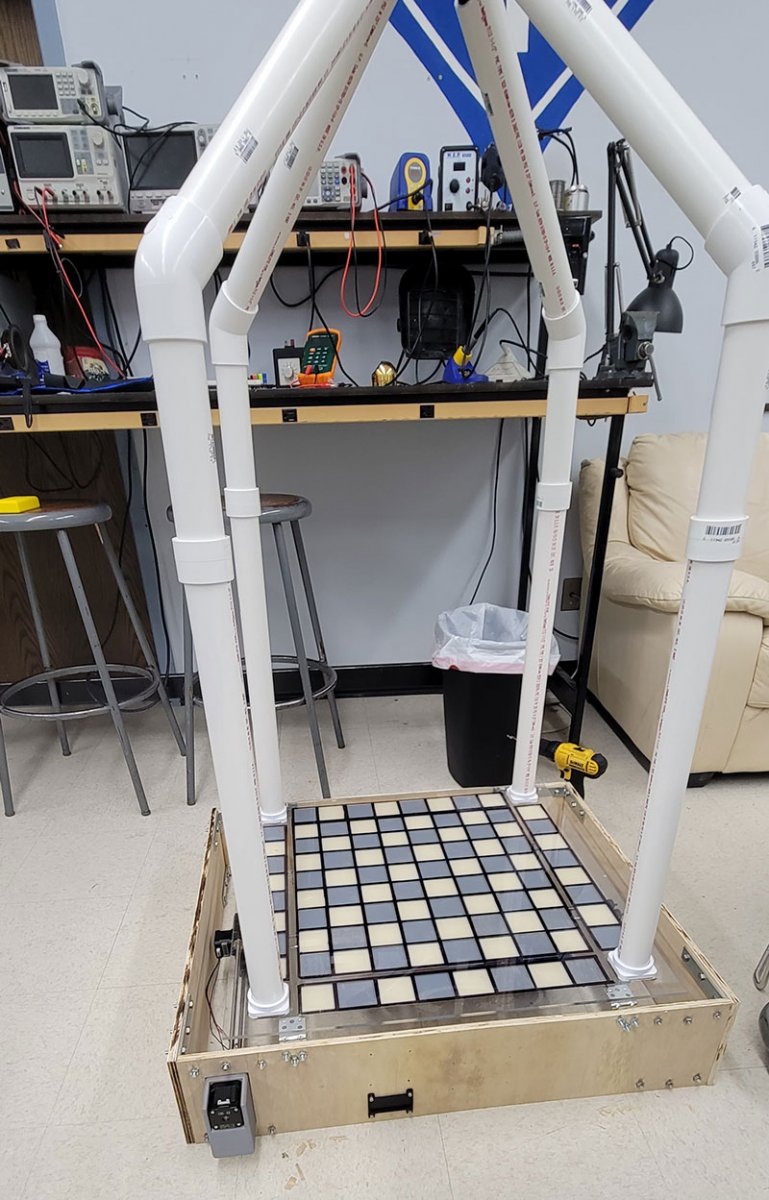
Team Members
Ryan Karl
Zury Vasquez
Aaron Norlinger
Sam Yunker
Faculty Supervisor
Mark Bauer
Project Description
Can you beat King Kobb at chess? Using computer vision, this chess board can play against you. Make a move, and the board will respond with its own.
Ryan Karl
Zury Vasquez
Aaron Norlinger
Sam Yunker
Faculty Supervisor
Mark Bauer
Project Description
Can you beat King Kobb at chess? Using computer vision, this chess board can play against you. Make a move, and the board will respond with its own.
Mueller Matrix Infrared Ellipsometer Using Rotating Anisotropic Mirrors

Team Members
Jenna Knudtson
Ellie Stone
Teresa Gramer
Henderson Gentillon
Faculty Supervisor
Mark Bauer
Project Description
We are building a Fourier transform infrared-range ellipsometer utilizing dual rotating anisotropic mirrors, resulting in a Mueller matrix characterization of a selected sample. A computer will interface with the infrared spectrometer, which will emit infrared light into our light path where it will reflect off a sample, enter our light path again, and be measured. The anisotropic mirrors are a simple way of polarizing light since light bounces off differently depending on its orientation.
We will be using two brushless-DC motors and 14-bit encoders using field-oriented control to rotate the mirrors. The computer will also control the motors through our motor-control hardware. Two STM32 microprocessors will be used, one in the motor control scheme, and another to acquire data from the spectrometer and send it commands. We are also using a goniometer to control the angle at which the infrared light hits the sample, so that the spectral range can be obtained across a range of angles.
Jenna Knudtson
Ellie Stone
Teresa Gramer
Henderson Gentillon
Faculty Supervisor
Mark Bauer
Project Description
We are building a Fourier transform infrared-range ellipsometer utilizing dual rotating anisotropic mirrors, resulting in a Mueller matrix characterization of a selected sample. A computer will interface with the infrared spectrometer, which will emit infrared light into our light path where it will reflect off a sample, enter our light path again, and be measured. The anisotropic mirrors are a simple way of polarizing light since light bounces off differently depending on its orientation.
We will be using two brushless-DC motors and 14-bit encoders using field-oriented control to rotate the mirrors. The computer will also control the motors through our motor-control hardware. Two STM32 microprocessors will be used, one in the motor control scheme, and another to acquire data from the spectrometer and send it commands. We are also using a goniometer to control the angle at which the infrared light hits the sample, so that the spectral range can be obtained across a range of angles.
Hybrid Drum Machine
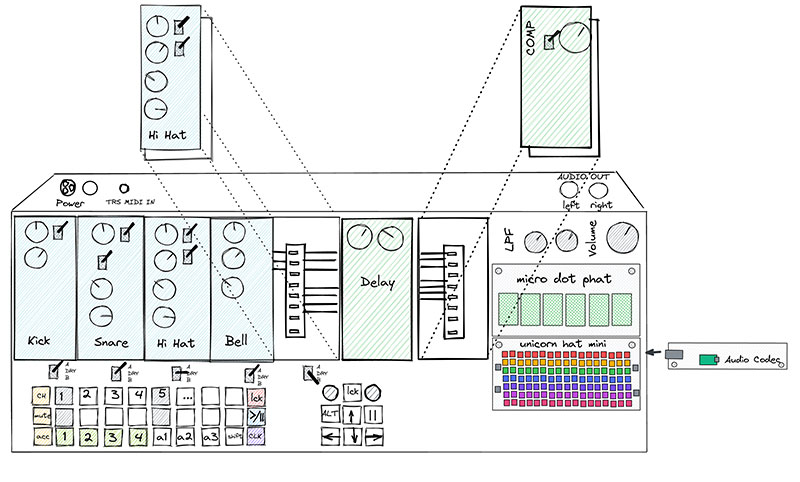
Team Members
Cole Sirokman
Reid Zimmerman
Vega Carlson
Kaleb McQuillan
Faculty Supervisor
Mark Bauer
Project Description
This analog and digital drum machine has a few main components – analog drum sound modules, analog and digital effect modules which provide optional changes to the sounds produced by the drums, filters and master volume control with dual channel audio output, and the sequencer. The modules are plug-and-play, meaning they can be removed and replaced with a simple slot design. The sequencer is 16-step, with control over the active modules, tempo, pattern sequencing, and micro step control.
Cole Sirokman
Reid Zimmerman
Vega Carlson
Kaleb McQuillan
Faculty Supervisor
Mark Bauer
Project Description
This analog and digital drum machine has a few main components – analog drum sound modules, analog and digital effect modules which provide optional changes to the sounds produced by the drums, filters and master volume control with dual channel audio output, and the sequencer. The modules are plug-and-play, meaning they can be removed and replaced with a simple slot design. The sequencer is 16-step, with control over the active modules, tempo, pattern sequencing, and micro step control.
Seeing Sparks: The Visualization of Sound Through Art
Team Members
Grace Larsen
Loc Diep
Amur Al harthi
Alec Brown
Faculty Supervisor
Mark Bauer
Project Description
Our project aims to create an artistic visualization of sound via a singing arc, which will heat up a plate of conductive material as it moves based on the characteristics of the sound being used. There are two methods of sound input – a live signal which will be recorded by a microphone and a sound file upload.
Grace Larsen
Loc Diep
Amur Al harthi
Alec Brown
Faculty Supervisor
Mark Bauer
Project Description
Our project aims to create an artistic visualization of sound via a singing arc, which will heat up a plate of conductive material as it moves based on the characteristics of the sound being used. There are two methods of sound input – a live signal which will be recorded by a microphone and a sound file upload.
Kobe Can
Team Members
Kylee Hauxwell
John Hosch
Kyle Hancock
Stephen Wilson
Faculty Supervisor
Mark Bauer
Project Description
Kobe Can is a semi-autonomous motorized trash can system. It actively scans the environment for thrown trash. When a piece of trash is detected, the motorized trash can will move to catch whatever was thrown at it, within a 6-foot diameter.
There are two parts to the Kobe Can: the motorized base and the overseer.
The motorized base consists of four DC motors, two drill batteries in parallel to drive the base, 3 encoder wheels to determine the position, and an RP2040 microcontroller for the brains of the operation. The trash can sits on top of this robot and is able to move in any direction to catch the flying trash.
The overseer consists of a depth-sensing camera (Intel RealSense D435). This component will allow the Kobe Can to determine a standardized flying object (yellow stress ball) amongst background noise and determine the intersection point. Python and OpenCV are being used to locate the ball and determine its projected trajectory. There will be communication between the trash receptacle and the overseer so the base will be able to receive the correct coordinates and move to the proper location. This communication will be done by an NRF24l01 module integrated into both the overseer and the base module.
Together, the motorized base and the overseer allow for the Kobe Can to detect and intercept a flying piece of trash. So, the next time you throw something away, say “Kobe … Can.”
Kylee Hauxwell
John Hosch
Kyle Hancock
Stephen Wilson
Faculty Supervisor
Mark Bauer
Project Description
Kobe Can is a semi-autonomous motorized trash can system. It actively scans the environment for thrown trash. When a piece of trash is detected, the motorized trash can will move to catch whatever was thrown at it, within a 6-foot diameter.
There are two parts to the Kobe Can: the motorized base and the overseer.
The motorized base consists of four DC motors, two drill batteries in parallel to drive the base, 3 encoder wheels to determine the position, and an RP2040 microcontroller for the brains of the operation. The trash can sits on top of this robot and is able to move in any direction to catch the flying trash.
The overseer consists of a depth-sensing camera (Intel RealSense D435). This component will allow the Kobe Can to determine a standardized flying object (yellow stress ball) amongst background noise and determine the intersection point. Python and OpenCV are being used to locate the ball and determine its projected trajectory. There will be communication between the trash receptacle and the overseer so the base will be able to receive the correct coordinates and move to the proper location. This communication will be done by an NRF24l01 module integrated into both the overseer and the base module.
Together, the motorized base and the overseer allow for the Kobe Can to detect and intercept a flying piece of trash. So, the next time you throw something away, say “Kobe … Can.”
Indoor Farming Enclosure
Team Members
Matt Poppen
Jeremy Thorne
Christian Espinoza
Cameron Biniamow
Faculty Supervisor
Herbert Detloff
Project Description
An automated climate-control system for an indoor-farming enclosure that allows the user to control the lighting, temperature, and humidity of the enclosure.
Matt Poppen
Jeremy Thorne
Christian Espinoza
Cameron Biniamow
Faculty Supervisor
Herbert Detloff
Project Description
An automated climate-control system for an indoor-farming enclosure that allows the user to control the lighting, temperature, and humidity of the enclosure.
RC GLOVE
Team Members
Daniel Webb
Rochak Rijal
Mahmood Albusaidi
Faculty Supervisor
Mark Bauer
Project Description
We developed a remote-control car that is controlled through rotational axis accelerometers. Using changes in angle, steering and acceleration can be controlled. The purpose is to provide alternate controls without joysticks and transfer to controls anything allowed to rotate.
Daniel Webb
Rochak Rijal
Mahmood Albusaidi
Faculty Supervisor
Mark Bauer
Project Description
We developed a remote-control car that is controlled through rotational axis accelerometers. Using changes in angle, steering and acceleration can be controlled. The purpose is to provide alternate controls without joysticks and transfer to controls anything allowed to rotate.
Measurement Suite
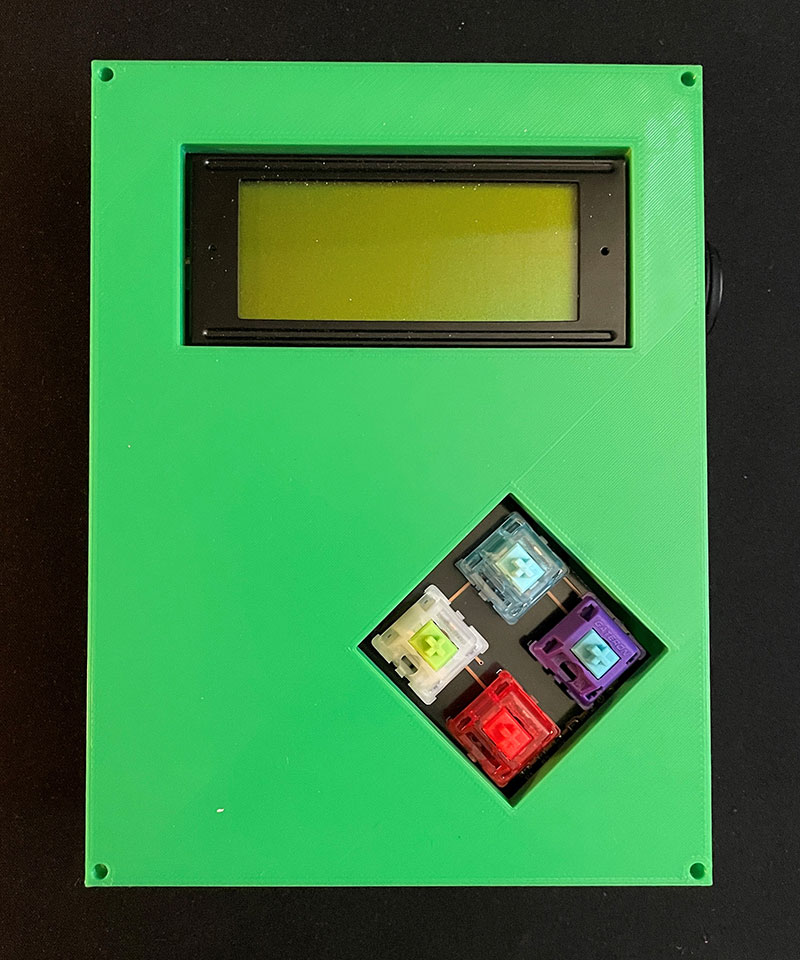
Team Members
Samuel Probst
Matthew Emory
Dalton Evans
Jake French
James Henry
Faculty Supervisor
Mark Bauer
Project Description
The measurement suite is multifunctional, designed around an ATMega328P microcontroller. It is meant to be a low-cost yet robust alternative to equivalent products on the market. The primary target demographic is high school science classrooms. The suite utilizes several external sensors to take its measurements (i.e., pH, temperature, humidity, mass, etc.). These measurements can be taken off of the device's local memory and transferred to a computer for later inspection.
Samuel Probst
Matthew Emory
Dalton Evans
Jake French
James Henry
Faculty Supervisor
Mark Bauer
Project Description
The measurement suite is multifunctional, designed around an ATMega328P microcontroller. It is meant to be a low-cost yet robust alternative to equivalent products on the market. The primary target demographic is high school science classrooms. The suite utilizes several external sensors to take its measurements (i.e., pH, temperature, humidity, mass, etc.). These measurements can be taken off of the device's local memory and transferred to a computer for later inspection.
Mechanical & Materials Engineering
Stair Descension Device for Wheelchair Application
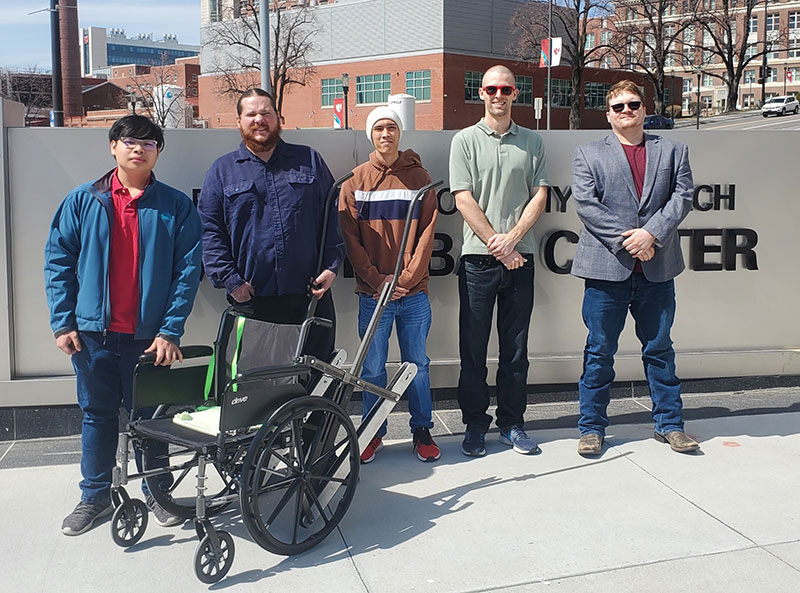
Team Members
Roman Schmidt
John Vu
Channing Schultz
Elijah Paulson
Nicholas Sippel
Faculty Supervisor
Florin Bobaru and Kurt Palik
Project Description
An improved evacuation system is needed for wheelchair-bound patients at University of Nebraska Medical Center. The system must allow for safe transportation of patients in wheelchairs down stairways while also reducing the overall evacuation time. We have built a wheelchair attachment that will unfold in case of an emergency.
Roman Schmidt
John Vu
Channing Schultz
Elijah Paulson
Nicholas Sippel
Faculty Supervisor
Florin Bobaru and Kurt Palik
Project Description
An improved evacuation system is needed for wheelchair-bound patients at University of Nebraska Medical Center. The system must allow for safe transportation of patients in wheelchairs down stairways while also reducing the overall evacuation time. We have built a wheelchair attachment that will unfold in case of an emergency.
NASA MicroG Lunar Anchoring Mechanism
Team Members
Ben Zwiener
Carson Emeigh
Trent Wiens
Evan Griess
Mike Sheridan
Faculty Supervisor
Carl Nelson
Project Description
Design an anchoring mechanism capable of attaching to the lunar surface to hold a variety of tools. Must be lightweight, compact, and waterproof. Cannot use external pressure or power.
Ben Zwiener
Carson Emeigh
Trent Wiens
Evan Griess
Mike Sheridan
Faculty Supervisor
Carl Nelson
Project Description
Design an anchoring mechanism capable of attaching to the lunar surface to hold a variety of tools. Must be lightweight, compact, and waterproof. Cannot use external pressure or power.
NASA MicroG NExT Sample Bag Dispenser

Team Members
Larissa Wehling
Mary Ankenbauer
Tyler Stoeger
Cassandra Amsden
Isaac Regier
Faculty Supervisor
Carl Nelson
Project Description
Our project is a sample bag dispenser system for the upcoming NASA Artemis missions. We worked with NASA through the MicroG NExT program to design our prototype, which will be tested in the Houston Neutral Buoyancy Laboratory in Houston, Texas, in June 2022. The dispenser holds bags until they are needed; the bags will hold moon samples and are specially engineered to be easily used while astronauts are in the EVA suit.
Larissa Wehling
Mary Ankenbauer
Tyler Stoeger
Cassandra Amsden
Isaac Regier
Faculty Supervisor
Carl Nelson
Project Description
Our project is a sample bag dispenser system for the upcoming NASA Artemis missions. We worked with NASA through the MicroG NExT program to design our prototype, which will be tested in the Houston Neutral Buoyancy Laboratory in Houston, Texas, in June 2022. The dispenser holds bags until they are needed; the bags will hold moon samples and are specially engineered to be easily used while astronauts are in the EVA suit.
Pediatric Shower Chair
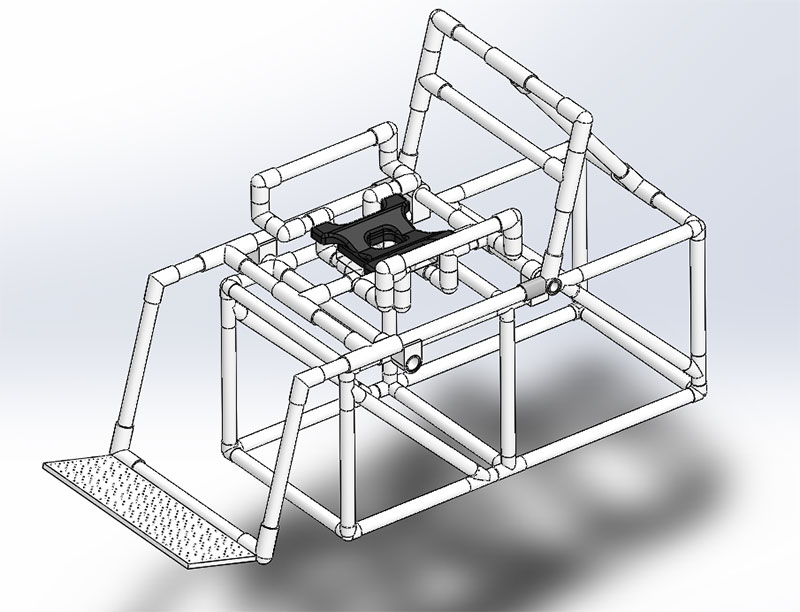
Team Members
Spencer Brabec
Matthew Jensen
Will Nielsen
Saud Ambu Saidi
Asama Younis Said Mohsin Al Quwaitai
Faculty Supervisor
Kurt Palik
Project Description
We are designing a pediatric shower chair that has an adjustable seat. The chair is meant to be used for children from ages 5-12. The chair will tilt about a single point to an angle of around ~45 degrees. This design is meant to be cheap, so all parts are made of PVC or a similar material to avoid the need for manufacturing thus keeping the price down. This is the second version of this project, which was started last year.
Spencer Brabec
Matthew Jensen
Will Nielsen
Saud Ambu Saidi
Asama Younis Said Mohsin Al Quwaitai
Faculty Supervisor
Kurt Palik
Project Description
We are designing a pediatric shower chair that has an adjustable seat. The chair is meant to be used for children from ages 5-12. The chair will tilt about a single point to an angle of around ~45 degrees. This design is meant to be cheap, so all parts are made of PVC or a similar material to avoid the need for manufacturing thus keeping the price down. This is the second version of this project, which was started last year.
Husker Racing Tension and Compression Tester
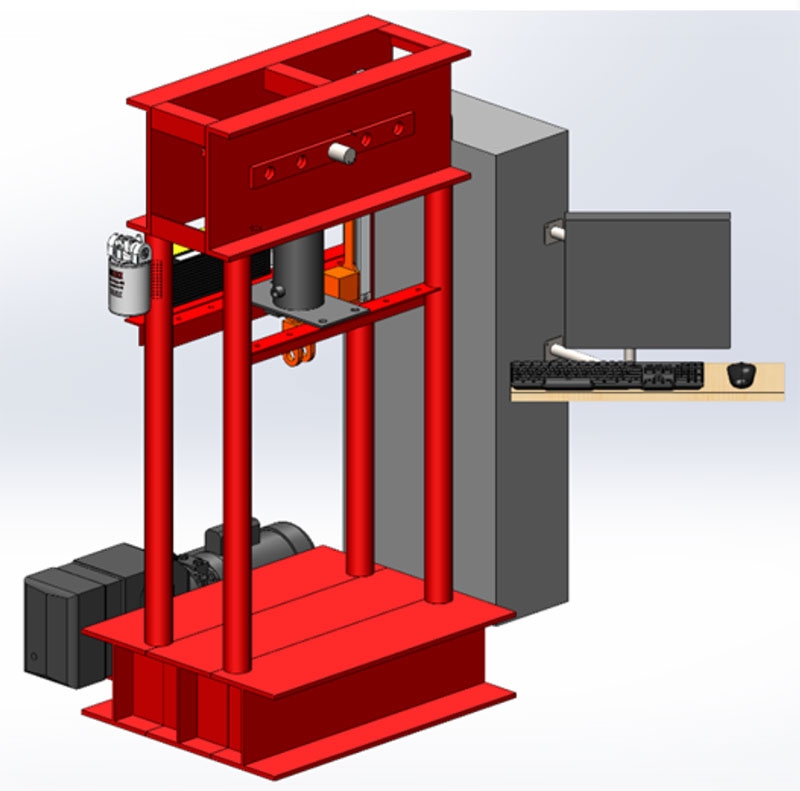
Team Members
Tyler McLaughlin
Zachary Johnson
Jeff Moore
Sean Thompsen
Thomas Jameson
Faculty Supervisor
Sangjin Ryu
Project Description
We are designing a hydraulic compression and tension tester for the Husker Racing Baja SAE team. This hydraulic press will be used to test the ultimate yield strength of Baja components. It will be used to test prototype parts and parts currently in use.
Tyler McLaughlin
Zachary Johnson
Jeff Moore
Sean Thompsen
Thomas Jameson
Faculty Supervisor
Sangjin Ryu
Project Description
We are designing a hydraulic compression and tension tester for the Husker Racing Baja SAE team. This hydraulic press will be used to test the ultimate yield strength of Baja components. It will be used to test prototype parts and parts currently in use.
Grain bag cleaning machine
Team Members
Chace Franey
Esteban Larranaga
Nicholas Christensen
Enrique Vargas
Kaleab Mengistu
Peter Kempf
Faculty Supervisor
Kurt Palik
Project Description
One significant struggle that rural farmers face regarding recycling is the sustainable disposal of the large plastic grain storage bags. These plastic bags are generally contaminated with dirt, mud, rocks, grain, and other particles that make the material unrecyclable. Our mission is to design a mobile mechanical device that will remove contaminating particles from the plastic grain storage bags, leaving a maximum of 5% contamination, effectively converting the bags into a recyclable material.
Chace Franey
Esteban Larranaga
Nicholas Christensen
Enrique Vargas
Kaleab Mengistu
Peter Kempf
Faculty Supervisor
Kurt Palik
Project Description
One significant struggle that rural farmers face regarding recycling is the sustainable disposal of the large plastic grain storage bags. These plastic bags are generally contaminated with dirt, mud, rocks, grain, and other particles that make the material unrecyclable. Our mission is to design a mobile mechanical device that will remove contaminating particles from the plastic grain storage bags, leaving a maximum of 5% contamination, effectively converting the bags into a recyclable material.
MS Forward Stretching Machine

Team Members
Zachary Henkenius
Aaron Haeffner
Darin Schlautman
Zach Mollohan
Nathan Hills
Faculty Supervisor
Kurt Palik
Project Description
The project focuses on designing and constructing a table that accommodates a hip-stretching attachment which will assist patients who have limited mobility with hip abduction and adduction. The hip-stretching device is a continuation of a previous design from last year, but a separate table was constructed due to the high volume of patients using the stretching table from the previous project. The table and stretching attachment were designed so that a user may transfer easily from their wheelchair to the table with little-to-no assistance.
Additionally, the means of controlling the hip-stretching machine were designed with the intention to be usable by all people, including those who may not have full use of both hands. The device could be operated solely by the user, but in practice it would be preferred to have a trainer present during use. Key features of this project include an adjustable backrest, emergency stop, easy operation via a joystick, and a sliding drawer to allow for storing the device while not in use. The design of the table and hip-stretching device have been analyzed and tested to ensure proper functionality.
Zachary Henkenius
Aaron Haeffner
Darin Schlautman
Zach Mollohan
Nathan Hills
Faculty Supervisor
Kurt Palik
Project Description
The project focuses on designing and constructing a table that accommodates a hip-stretching attachment which will assist patients who have limited mobility with hip abduction and adduction. The hip-stretching device is a continuation of a previous design from last year, but a separate table was constructed due to the high volume of patients using the stretching table from the previous project. The table and stretching attachment were designed so that a user may transfer easily from their wheelchair to the table with little-to-no assistance.
Additionally, the means of controlling the hip-stretching machine were designed with the intention to be usable by all people, including those who may not have full use of both hands. The device could be operated solely by the user, but in practice it would be preferred to have a trainer present during use. Key features of this project include an adjustable backrest, emergency stop, easy operation via a joystick, and a sliding drawer to allow for storing the device while not in use. The design of the table and hip-stretching device have been analyzed and tested to ensure proper functionality.
Pneumatic Leg Press Workout Machine for Users with Multple Sclerosis
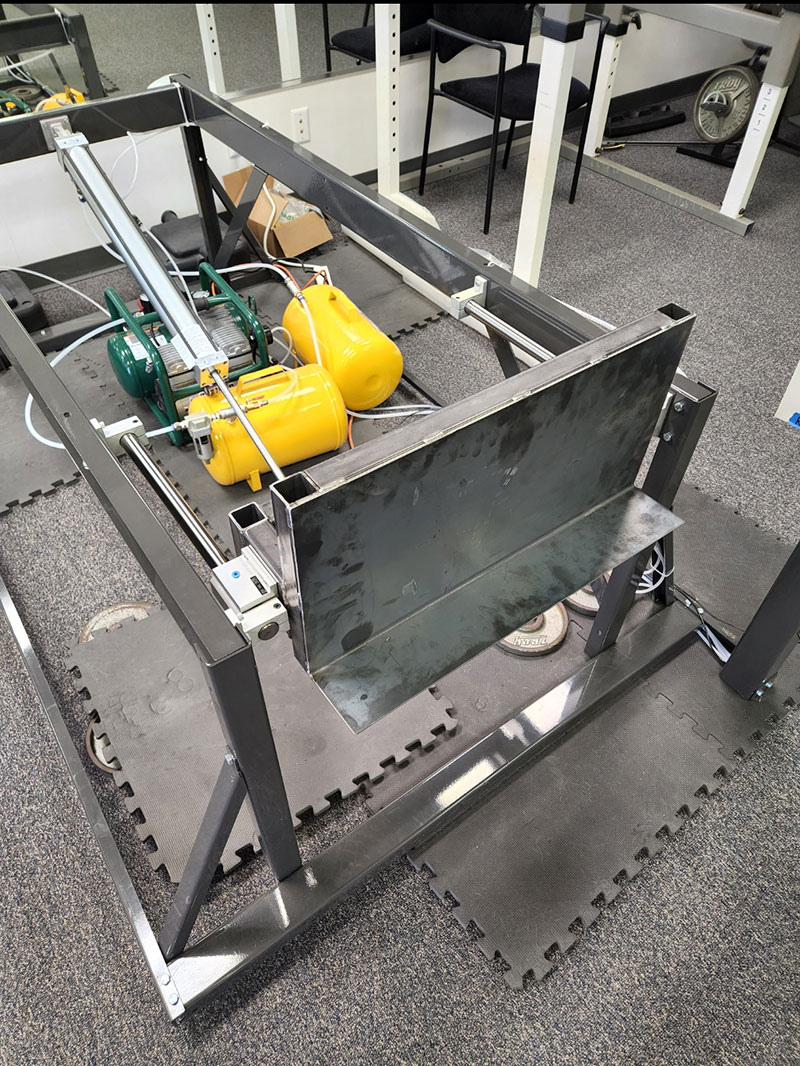
Team Members
Alexander Eisele
Alexandria Persing
Sammy Bannister
Mohsin Al Barwani
Ahmed Sulaiman
Jay Allen
Faculty Supervisor
Keegan Moore
Project Description
This project was given to us by MS Forward, a gym for people with multiple sclerosis (MS). By making a pneumatic-driven leg press machine, the users are able to safely release all pressure on the legs in the case of a spasm, common in people with MS. Given previous years' designs, we were able to make major improvements to the push plate actuation, add a leg stabilization mechanism, and add a built-in chair.
Alexander Eisele
Alexandria Persing
Sammy Bannister
Mohsin Al Barwani
Ahmed Sulaiman
Jay Allen
Faculty Supervisor
Keegan Moore
Project Description
This project was given to us by MS Forward, a gym for people with multiple sclerosis (MS). By making a pneumatic-driven leg press machine, the users are able to safely release all pressure on the legs in the case of a spasm, common in people with MS. Given previous years' designs, we were able to make major improvements to the push plate actuation, add a leg stabilization mechanism, and add a built-in chair.
Shingling Robot
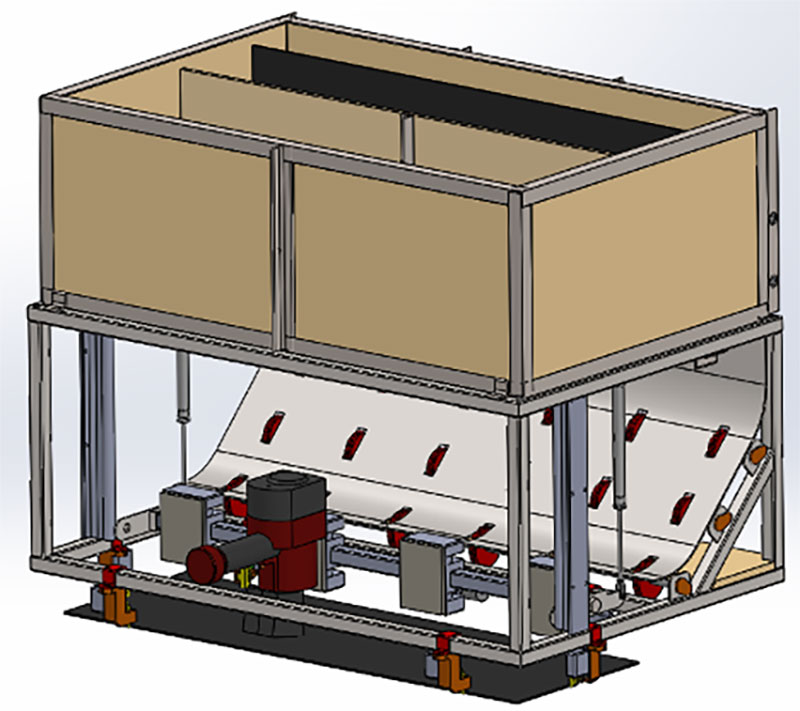
Team Members
Victoria Nelson
Brandon Kusek
Isaac Klar
Carter McCormick
River Kramer
Faculty Supervisor
Carl Nelson
Project Description
Roofing houses has a high injury rate for workers. The goal of this project is to limit the amount of time workers spend working on top of roofs by creating a robot that will shingle roofs. This robot can autonomously move on a roof, align a shingle, and nail a shingle to the roof. This decreases the amount of time a worker spends on the roof and the risk of injury due to working on a roof.
Victoria Nelson
Brandon Kusek
Isaac Klar
Carter McCormick
River Kramer
Faculty Supervisor
Carl Nelson
Project Description
Roofing houses has a high injury rate for workers. The goal of this project is to limit the amount of time workers spend working on top of roofs by creating a robot that will shingle roofs. This robot can autonomously move on a roof, align a shingle, and nail a shingle to the roof. This decreases the amount of time a worker spends on the roof and the risk of injury due to working on a roof.
Liquid Chemical Dispenser for Viscous Materials
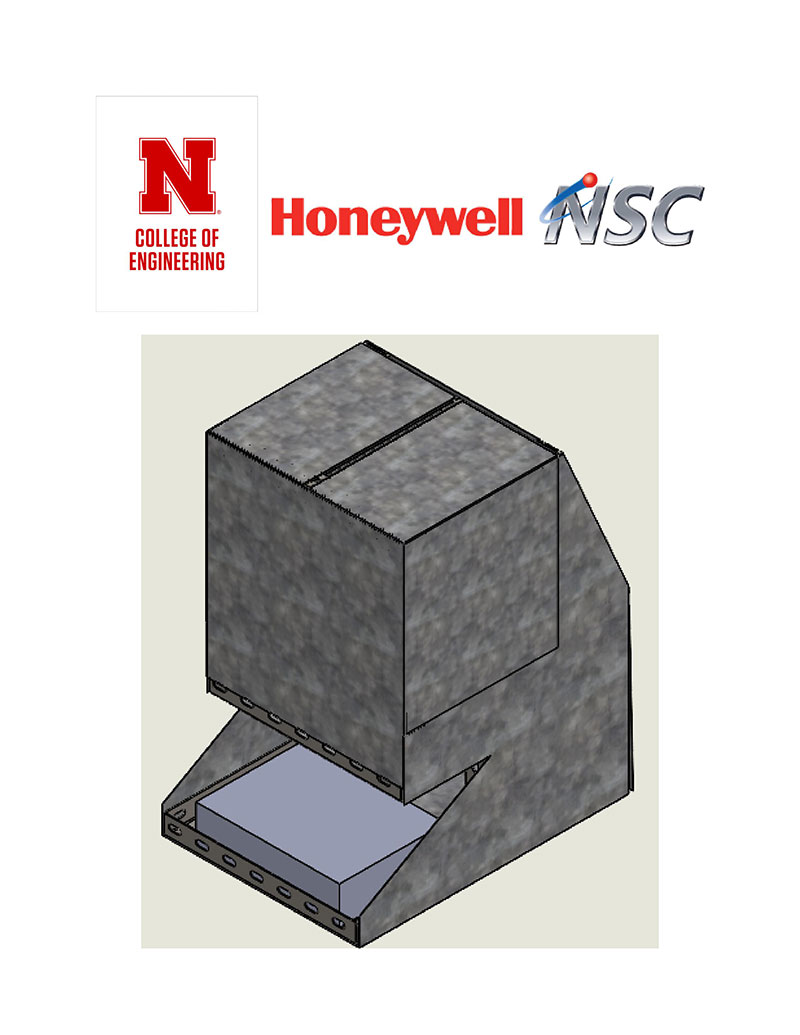
Team Members
Jacob Cederberg
Adam Nebelsick
Austen Nichols
Henry Bohac
Jonathan Izaguirre
Faculty Supervisor
Sangjin Ryu
Project Description
The purpose of the project is to design, build, and test a chemical dispenser that can repeatedly dispense viscous materials accurately and precisely. The customer's current manufacturing process relies on hand pouring of materials from their packaging containers into a mixing vessel. This method can not only be unreliable but unpleasant.
Accuracy is important for the application these chemicals are used for and keeping the dispensing method as clean as possible is essential. The fabrication of this dispenser required sufficient knowledge in the fields of fluid mechanics, material science, electronics, programming, and manufacturing.
Jacob Cederberg
Adam Nebelsick
Austen Nichols
Henry Bohac
Jonathan Izaguirre
Faculty Supervisor
Sangjin Ryu
Project Description
The purpose of the project is to design, build, and test a chemical dispenser that can repeatedly dispense viscous materials accurately and precisely. The customer's current manufacturing process relies on hand pouring of materials from their packaging containers into a mixing vessel. This method can not only be unreliable but unpleasant.
Accuracy is important for the application these chemicals are used for and keeping the dispensing method as clean as possible is essential. The fabrication of this dispenser required sufficient knowledge in the fields of fluid mechanics, material science, electronics, programming, and manufacturing.
School of Computing
School of Computing Senior DesignCare Bridge International - Claims Intelligence Platform
Team Members
Simon Schoenbeck
Wencheng Bao
Ujwal Ghatamaneni
Sam Rilett
Sajal Risal
Serigne Toure
Faculty Supervisor
Vinod Variyam
Project Description
Predicting the future lifetime medical costs of patients, especially those with extreme conditions or injuries, is difficult. The team designed and executed a process for developing machine learning models to predict the probability of certain events occurring and computing these probabilities into an expected cost.
Simon Schoenbeck
Wencheng Bao
Ujwal Ghatamaneni
Sam Rilett
Sajal Risal
Serigne Toure
Faculty Supervisor
Vinod Variyam
Project Description
Predicting the future lifetime medical costs of patients, especially those with extreme conditions or injuries, is difficult. The team designed and executed a process for developing machine learning models to predict the probability of certain events occurring and computing these probabilities into an expected cost.
City of Lincoln – Renter & Landlord Community Education Tool
Team Members
Taylor Satterfield
Austin Aldana
Dalton Hulett
Alexander Kupec
Benjamin Reisen
Gianni Young
Faculty Supervisor
Shruti Bolman
Project Description
The Renter & Landlord Education Tool was developed to help reduce eviction rates by digitalizing two separate free courses offered by the City of Lincoln & the Nebraska Housing Developers Association. Previously, the classes were taught by a trained instructor and the courses included quizzes and in-class activities. The project adapted this process into a digital version that rewards the users with a printable certificate and allows agencies and housing providers to view a public reporting database, while instructors play a more passive role through checking users progress and being available to answer questions.
Taylor Satterfield
Austin Aldana
Dalton Hulett
Alexander Kupec
Benjamin Reisen
Gianni Young
Faculty Supervisor
Shruti Bolman
Project Description
The Renter & Landlord Education Tool was developed to help reduce eviction rates by digitalizing two separate free courses offered by the City of Lincoln & the Nebraska Housing Developers Association. Previously, the classes were taught by a trained instructor and the courses included quizzes and in-class activities. The project adapted this process into a digital version that rewards the users with a printable certificate and allows agencies and housing providers to view a public reporting database, while instructors play a more passive role through checking users progress and being available to answer questions.
Civic Nebraska – Election Protection Program
Team Members
Troy Ogden
Sebastian Ignacio Alegrett Morreo
Andrew Hazel
Sean Hollibaugh
Kyle Kobza
Samuel Thompson
Faculty Supervisor
Brady Garvin
Project Description
The goal of the Election Protection Program is to allow poll observers and Civic Nebraska employees to electronically fill out, submit, and review poll-observation, ADA-issue, and voter-issue forms. These forms were previously all on paper, but our project has created a React mobile application that has digitized this process.
Troy Ogden
Sebastian Ignacio Alegrett Morreo
Andrew Hazel
Sean Hollibaugh
Kyle Kobza
Samuel Thompson
Faculty Supervisor
Brady Garvin
Project Description
The goal of the Election Protection Program is to allow poll observers and Civic Nebraska employees to electronically fill out, submit, and review poll-observation, ADA-issue, and voter-issue forms. These forms were previously all on paper, but our project has created a React mobile application that has digitized this process.
Connections Homes – Youth Matching Tool
Team Members
Caleb Marcoux
Jiakai Li
Alexis Linhardt
Rainier Sarreal
Haley Shaw
Jacob Sloup
Faculty Supervisor
Vinod Variyam
Project Description
This project was to create a matching algorithm and accompanying tool for the Connection Homes organization to use. The solution the team created was building a web application that runs using AWS lambda functions and incorporates their existing databases on Airtable.
Caleb Marcoux
Jiakai Li
Alexis Linhardt
Rainier Sarreal
Haley Shaw
Jacob Sloup
Faculty Supervisor
Vinod Variyam
Project Description
This project was to create a matching algorithm and accompanying tool for the Connection Homes organization to use. The solution the team created was building a web application that runs using AWS lambda functions and incorporates their existing databases on Airtable.
DMSi – Reman Mobile App
Team Members
Michael Westberg
Ethan Fox
Adam Leppky
Sailesh Pujara
Emily Schnepel
Faculty Supervisor
Bhuvana Gopal
Project Description
We created iOS and Android mobile applications for managing the remanufacturing process (or reman for short) for clients. This application eliminated multiple-step processes involved in the reman process and helped remove the usage of paper in warehouses, effectively streamlining the overall reman process.
Michael Westberg
Ethan Fox
Adam Leppky
Sailesh Pujara
Emily Schnepel
Faculty Supervisor
Bhuvana Gopal
Project Description
We created iOS and Android mobile applications for managing the remanufacturing process (or reman for short) for clients. This application eliminated multiple-step processes involved in the reman process and helped remove the usage of paper in warehouses, effectively streamlining the overall reman process.
Entrepreneurs – Surrealist Shooter Game
Team Members
Jaden Goter
Ethan Dyas
Matthew Lowe
Camden Obertop
Tanner Skelton
Faculty Supervisor
Chris Bohn
Project Description
Twenty years past the height of its popularity, the movement shooter video game genre makes a comeback! However, most modern movement shooters are quite linear experiences and fail to take the genre to the next level. With Neural Nest, the team wanted to provide an experience that players can’t get anywhere else – a surrealist, hand-drawn movement shooter with non-linear adventure aspects.
Jaden Goter
Ethan Dyas
Matthew Lowe
Camden Obertop
Tanner Skelton
Faculty Supervisor
Chris Bohn
Project Description
Twenty years past the height of its popularity, the movement shooter video game genre makes a comeback! However, most modern movement shooters are quite linear experiences and fail to take the genre to the next level. With Neural Nest, the team wanted to provide an experience that players can’t get anywhere else – a surrealist, hand-drawn movement shooter with non-linear adventure aspects.
Freeman Preparation Program – FPP App and Institution Integration
Team Members
Alex Stumpff
Jayden Carlon
Salman Djingueinabaye
Ze Han
Emily Pfeiler
Calvin Shafer
Faculty Supervisor
Bhuvana Gopal
Project Description
The objective of the Freeman Preparation Program is to develop an app that enables users to psychologically prepare for a wide variety of medical procedures with reduced stress and pain. The content of the app will be a mix of audio, text, and video specifically created to ease anxiety and fears. This project is founded by psychologist Shelley Freeman with research completed under the UNL Psychology Department. It Dr. Freeman’s dream to partner with hospitals around the world and provide them a way to help the psychological health of their patients.
Alex Stumpff
Jayden Carlon
Salman Djingueinabaye
Ze Han
Emily Pfeiler
Calvin Shafer
Faculty Supervisor
Bhuvana Gopal
Project Description
The objective of the Freeman Preparation Program is to develop an app that enables users to psychologically prepare for a wide variety of medical procedures with reduced stress and pain. The content of the app will be a mix of audio, text, and video specifically created to ease anxiety and fears. This project is founded by psychologist Shelley Freeman with research completed under the UNL Psychology Department. It Dr. Freeman’s dream to partner with hospitals around the world and provide them a way to help the psychological health of their patients.
Jackson Family Foundation – Funding Partner Interactive Map
Team Members
Evan Palmer
Joshua Baesler
Matthew Kerian
Shelby Miller
Andres Ruiz
Faculty Supervisor
Shruti Bolman
Project Description
Jackson Family Foundation (JFF) interacts with many global partners and is actively managing their partnership portfolio; however, JFF does not have a usable interface to support their strategic goals as it relates to partner and project management. The solution created by this team is an interactive map designed to enable JFF to evaluate the geographic areas that have sufficient or insufficient partners and projects.
Evan Palmer
Joshua Baesler
Matthew Kerian
Shelby Miller
Andres Ruiz
Faculty Supervisor
Shruti Bolman
Project Description
Jackson Family Foundation (JFF) interacts with many global partners and is actively managing their partnership portfolio; however, JFF does not have a usable interface to support their strategic goals as it relates to partner and project management. The solution created by this team is an interactive map designed to enable JFF to evaluate the geographic areas that have sufficient or insufficient partners and projects.
Nebraska Game and Parks – Field App for Fisheries Field Sampling
Team Members
Jadyn Larsen
Cameron Collingham
Michael Kawamoto
Hunter Oestmann
Patrick Orel
Aleka Schlake
Faculty Supervisor
Brady Garvin
Project Description
The Fisheries Division has been using a pen-and-paper method to survey bodies of water. After recording the data on paper, it is copied into a computer and uploaded to the database. The Field App for Fisheries Field Sampling was designed to eliminate the need for redundant data recording by directly saving and uploading the data.
Jadyn Larsen
Cameron Collingham
Michael Kawamoto
Hunter Oestmann
Patrick Orel
Aleka Schlake
Faculty Supervisor
Brady Garvin
Project Description
The Fisheries Division has been using a pen-and-paper method to survey bodies of water. After recording the data on paper, it is copied into a computer and uploaded to the database. The Field App for Fisheries Field Sampling was designed to eliminate the need for redundant data recording by directly saving and uploading the data.
Nebraska Water Center – Vadose Zone Database & User Interface
Team Members
Cody Binder
Patrick McManigal
Collin Sipple
William Swiston
Cole Vaske
Faculty Supervisor
Shruti Bolman
Project Description
For this project, the Nebraska Water Center required a robust method for monitoring data related to groundwater management, which includes various chemicals and compounds found in Nebraska’s soil. The Vadose Zone Database & User Interface project sought to design a website capable of parsing large amounts of data via Excel file, which would then be passed into a database capable of housing this data. The website needed to be able to present all data in a way that its administrators can maintain the quantity of data without sacrificing quality.
Cody Binder
Patrick McManigal
Collin Sipple
William Swiston
Cole Vaske
Faculty Supervisor
Shruti Bolman
Project Description
For this project, the Nebraska Water Center required a robust method for monitoring data related to groundwater management, which includes various chemicals and compounds found in Nebraska’s soil. The Vadose Zone Database & User Interface project sought to design a website capable of parsing large amounts of data via Excel file, which would then be passed into a database capable of housing this data. The website needed to be able to present all data in a way that its administrators can maintain the quantity of data without sacrificing quality.
UNL CAVE Lab – Husker Concussion Mobile Application
Team Members
Bethany Krull
JP Jensen
Martin Nguyen
Nina Ong
Garrett Roth
Michael Vipond
Faculty Supervisor
Jeffrey Falkinburg
Project Description
It is unfortunately common for student athletes to not receive the proper rehabilitative care for concussions, and even if they do receive the proper care, it is likely that the athlete will drop their treatment regimen. The team was tasked to create an application suite to aid the UNL CAVE Lab in assigning treatment plans to athletes and ensuring that athletes would complete these plans.
To facilitate this, the team worked on three deliverables – a Web-based application for CAVE Lab staff to enter athletes into the system, assign them exercises, and monitor their progress through their assigned treatments – and two mobile applications (one for Android and one for iOS) for use by athletes to perform their exercises and rate their symptoms during those exercises.
Bethany Krull
JP Jensen
Martin Nguyen
Nina Ong
Garrett Roth
Michael Vipond
Faculty Supervisor
Jeffrey Falkinburg
Project Description
It is unfortunately common for student athletes to not receive the proper rehabilitative care for concussions, and even if they do receive the proper care, it is likely that the athlete will drop their treatment regimen. The team was tasked to create an application suite to aid the UNL CAVE Lab in assigning treatment plans to athletes and ensuring that athletes would complete these plans.
To facilitate this, the team worked on three deliverables – a Web-based application for CAVE Lab staff to enter athletes into the system, assign them exercises, and monitor their progress through their assigned treatments – and two mobile applications (one for Android and one for iOS) for use by athletes to perform their exercises and rate their symptoms during those exercises.
UNL SOC-Bohn – Matching And Grouping of Interests for Capstone
Team Members
Brent Miller
Amy Tran
Ikhlaas Ahmud Mungloo
Faculty Supervisor
Chris Bohn
Project Description
The team was challenged to automate the matching and grouping of students to a Senior Design project. This process included assigning students based on their project preferences, major, leadership preferences, prerequisite performance, teammate preferences, and the preferences of the Senior Design student base overall. As a solution, the team created a web-based application, which used a merging and sorting algorithm to allot students to an available project based on the criteria and their best possible preference.
Brent Miller
Amy Tran
Ikhlaas Ahmud Mungloo
Faculty Supervisor
Chris Bohn
Project Description
The team was challenged to automate the matching and grouping of students to a Senior Design project. This process included assigning students based on their project preferences, major, leadership preferences, prerequisite performance, teammate preferences, and the preferences of the Senior Design student base overall. As a solution, the team created a web-based application, which used a merging and sorting algorithm to allot students to an available project based on the criteria and their best possible preference.
UNL SOC-Bourke – Project 046
Team Members
Jonathan Svoboda
Trevor Ives
Cade Rasmussen
Daniel Rudebusch
Faculty Supervisor
Jeffrey Falkinburg
Project Description
The team was tasked to create a 3D, narrative-based, psychological horror video game while cooperatively developing and designing it with a team from the Center of Emerging Media Arts (CEMA). Using Unity and Maya, the development team and the CEMA team have created the game Project 046 in accordance with the designated parameters.
Jonathan Svoboda
Trevor Ives
Cade Rasmussen
Daniel Rudebusch
Faculty Supervisor
Jeffrey Falkinburg
Project Description
The team was tasked to create a 3D, narrative-based, psychological horror video game while cooperatively developing and designing it with a team from the Center of Emerging Media Arts (CEMA). Using Unity and Maya, the development team and the CEMA team have created the game Project 046 in accordance with the designated parameters.
UNL SOC-Falkinburg-Daniel – Husker Scope
Team Members
Brandon Ramos
Ben Buckwalter
Christian Lampe
Isaac Lien
Riddock Moran
Michael Rahe
Faculty Supervisor
Vinod Variyam
Project Description
The reason for this project was the lack of an all-in-one app for a function generator and oscilloscope that was free and had a version for both iOS and Android devices. Our goal was to provide a free and cross-platform application containing a function generator and oscilloscope that will be available to UNL students and engineering students across the globe.
Brandon Ramos
Ben Buckwalter
Christian Lampe
Isaac Lien
Riddock Moran
Michael Rahe
Faculty Supervisor
Vinod Variyam
Project Description
The reason for this project was the lack of an all-in-one app for a function generator and oscilloscope that was free and had a version for both iOS and Android devices. Our goal was to provide a free and cross-platform application containing a function generator and oscilloscope that will be available to UNL students and engineering students across the globe.
UNL SOC-Falkinburg-Palmer – Husker STEM VR
Team Members
Parker Brown
Jackson Herman
Jackson Maschman
Ryan Schumacher
Tyler Senne
Connor Unger
Faculty Supervisor
Bhuvana Gopal
Project Description
The Husker STEM VR project is an outreach/recruitment app being built for the Oculus Quest. Students are building a virtual reality Oculus Quest app for UNL's School of Computing and College of Engineering to encourage STEM outreach. This app will help to make learning fun by creating a virtual-reality app designed to create an engaging learning environment. Additionally, we can promote more diversity in STEM by creating an educational environment that promotes inclusiveness.
Parker Brown
Jackson Herman
Jackson Maschman
Ryan Schumacher
Tyler Senne
Connor Unger
Faculty Supervisor
Bhuvana Gopal
Project Description
The Husker STEM VR project is an outreach/recruitment app being built for the Oculus Quest. Students are building a virtual reality Oculus Quest app for UNL's School of Computing and College of Engineering to encourage STEM outreach. This app will help to make learning fun by creating a virtual-reality app designed to create an engaging learning environment. Additionally, we can promote more diversity in STEM by creating an educational environment that promotes inclusiveness.
UNL SOC-Koopmann-Samal – LA Program Management Tool
Team Members
Aaron Friesen
Joel Hernandez
ZhiWei Jin
Dan Navarro
Ethan Weber
Noah Costello
Faculty Supervisor
Jeffrey Falkinburg
Project Description
The UNL Learning Assistant Program uses an application called LAProMT to manage hiring, office hours, and on-demand appointments. This year, the team augmented LAProMT with a complete evaluation subsystem that allows the program coordinators to create evaluations, collect responses from learning assistants, and view evaluation summaries, thereby replacing and streamlining their previous Google Forms-based workflow.
Aaron Friesen
Joel Hernandez
ZhiWei Jin
Dan Navarro
Ethan Weber
Noah Costello
Faculty Supervisor
Jeffrey Falkinburg
Project Description
The UNL Learning Assistant Program uses an application called LAProMT to manage hiring, office hours, and on-demand appointments. This year, the team augmented LAProMT with a complete evaluation subsystem that allows the program coordinators to create evaluations, collect responses from learning assistants, and view evaluation summaries, thereby replacing and streamlining their previous Google Forms-based workflow.
UNL SOC-Vuran – OneLNK - A Link to Rule All Radios
Team Members
Chris Galusha
Noah Anderson
Jonah Burke
Chase Prochnow
Alex Rechsteiner
Guy Richard
Faculty Supervisor
Brady Garvin
Project Description
The team created multiple systems for programmable radios. The team developed a GUI for interfacing with the wireless test beds, a fully featured health-check for radio health, and an AWS layer with MQTT and AWS IoT that securely handled radio data.
Chris Galusha
Noah Anderson
Jonah Burke
Chase Prochnow
Alex Rechsteiner
Guy Richard
Faculty Supervisor
Brady Garvin
Project Description
The team created multiple systems for programmable radios. The team developed a GUI for interfacing with the wireless test beds, a fully featured health-check for radio health, and an AWS layer with MQTT and AWS IoT that securely handled radio data.
UNL SOC-Yao – A New pyP3DB
Team Members
Todd Bush
Michael Hunteman
Jack Kieny
Aryan Timla
Zhiyuan Weng
Linhan Li
Faculty Supervisor
Brady Garvin
Project Description
Our mission was: Create a new pyP3DB website to be used by researchers within academia for the next 10+ years with additional features like user roles, update the current database to include additional types of protein modification and several different pieces of research from different authors, and have secure logins for researchers and to have consistency upon viewing, uploading, and managing data.
Todd Bush
Michael Hunteman
Jack Kieny
Aryan Timla
Zhiyuan Weng
Linhan Li
Faculty Supervisor
Brady Garvin
Project Description
Our mission was: Create a new pyP3DB website to be used by researchers within academia for the next 10+ years with additional features like user roles, update the current database to include additional types of protein modification and several different pieces of research from different authors, and have secure logins for researchers and to have consistency upon viewing, uploading, and managing data.
UNL Gudmundsen Sandhills Laboratory – Livestock Data Analytics
Team Members
Andrew Wiedenmann
Riley Ellwanger
John Erwin
David Estrada
Mario Gomez
Isaac Werner
Faculty Supervisor
Shruti Bolman
Project Description
The team created a cloud-based, cattle-livestock management and data visualization web application solution for the Gudmundsen Sandhills Laboratory, a university research facility. Leveraging Amazon Web Services cloud infrastructure, the team delivered a novel solution to managing large amounts of cattle livestock management data.
Andrew Wiedenmann
Riley Ellwanger
John Erwin
David Estrada
Mario Gomez
Isaac Werner
Faculty Supervisor
Shruti Bolman
Project Description
The team created a cloud-based, cattle-livestock management and data visualization web application solution for the Gudmundsen Sandhills Laboratory, a university research facility. Leveraging Amazon Web Services cloud infrastructure, the team delivered a novel solution to managing large amounts of cattle livestock management data.
UNL Holland Computing Center – Enhancing RNA Nanostructures Science Gateway
Team Members
Abdullah Hamad
Josh Bearden
Peter Cao
Katie Gerot
Trent McElmury
Kevin Wertz
Faculty Supervisor
Vinod Variyam
Project Description
RNAMake is a toolkit for designing and optimizing RNA 3D structure that was restricted to the command-line. The team designed an accessible front-end application for RNAMake that allows biologists and students from across the country to use the application.
Abdullah Hamad
Josh Bearden
Peter Cao
Katie Gerot
Trent McElmury
Kevin Wertz
Faculty Supervisor
Vinod Variyam
Project Description
RNAMake is a toolkit for designing and optimizing RNA 3D structure that was restricted to the command-line. The team designed an accessible front-end application for RNAMake that allows biologists and students from across the country to use the application.
UNL School of Natural Resources – StreamNet
Team Members
Cortney Oltjenbruns
Lukas Didrichsons
Drew Lauby
Reed Lawrence
Thi Nguyen
Davey Winter
Faculty Supervisor
Brady Garvin
Project Description
The team was tasked with developing backend infrastructure for the intake, storage, and processing of sensor data. We then took that data and served it to the frontend for easy viewing in a graphical representation. The site was set up to be hosted on the streamnet.unl.edu domain.
Cortney Oltjenbruns
Lukas Didrichsons
Drew Lauby
Reed Lawrence
Thi Nguyen
Davey Winter
Faculty Supervisor
Brady Garvin
Project Description
The team was tasked with developing backend infrastructure for the intake, storage, and processing of sensor data. We then took that data and served it to the frontend for easy viewing in a graphical representation. The site was set up to be hosted on the streamnet.unl.edu domain.
UNL TAPS – Streamlining TAPS Data
Team Members
Ryan Lindsay
Kai Guo
Yicong Mo
William Prewitt
Uyen Tran
Stephanie Marsh
Faculty Supervisor
Vinod Variyam
Project Description
The team was tasked with creating a solution to create a streamlined process for the addition of data to Excel files. When a participant or UNL TAPS member submits data for a competition, this project allows the data to automatically be updated in the respective Excel files stored in Sharepoint. Also, allowing for the data to be searchable so people can see the information that comes from the competitions is a long-term goal of the project.
Ryan Lindsay
Kai Guo
Yicong Mo
William Prewitt
Uyen Tran
Stephanie Marsh
Faculty Supervisor
Vinod Variyam
Project Description
The team was tasked with creating a solution to create a streamlined process for the addition of data to Excel files. When a participant or UNL TAPS member submits data for a competition, this project allows the data to automatically be updated in the respective Excel files stored in Sharepoint. Also, allowing for the data to be searchable so people can see the information that comes from the competitions is a long-term goal of the project.
UNMC College of Nursing – VR Ag Safety Continuation
Team Members
Chris Zagurski
Michael Ervin
Noah Liebers
Connor Pumilia
Alex Story
Faculty Supervisor
Jeffrey Falkinburg
Project Description
An immersive VR experience that looks to simulate real-life tasks to promote farm safety for all. The project currently has three pillars – tractor safety, ATV safety, and electrical safety.
Chris Zagurski
Michael Ervin
Noah Liebers
Connor Pumilia
Alex Story
Faculty Supervisor
Jeffrey Falkinburg
Project Description
An immersive VR experience that looks to simulate real-life tasks to promote farm safety for all. The project currently has three pillars – tractor safety, ATV safety, and electrical safety.
Werner Enterprises – Messaging and Current Load React App Modules
Team Members
Juan Guzman
Chase Hermreck
Calen Olsen
Karnav Sharadkumar Patel
Tai Vo
Song Zheng
Faculty Supervisor
Bhuvana Gopal
Project Description
The team was tasked with creating components that display trailer information and road conditions for drivers and other associates. The team aimed for modular code that could be integrated into the sponsor’s existing application, Drive Werner Pro. The final product is a standalone application that demonstrates these components, which include maps that show wind and weather and a map that displays the locations of trailers in Werner’s area of operations (among other information such as cargo status, latitude/longitude, etc.).
Juan Guzman
Chase Hermreck
Calen Olsen
Karnav Sharadkumar Patel
Tai Vo
Song Zheng
Faculty Supervisor
Bhuvana Gopal
Project Description
The team was tasked with creating components that display trailer information and road conditions for drivers and other associates. The team aimed for modular code that could be integrated into the sponsor’s existing application, Drive Werner Pro. The final product is a standalone application that demonstrates these components, which include maps that show wind and weather and a map that displays the locations of trailers in Werner’s area of operations (among other information such as cargo status, latitude/longitude, etc.).